Assisi Italy, a hilltop castle, cypress and olive groves, renaissance churches, and Roman temples alone would be worth the drive across the wheat fields of Umbria, but it’s one former inhabitant that sets this town apart – St. Francis of Assisi, the patron saint of Italy.
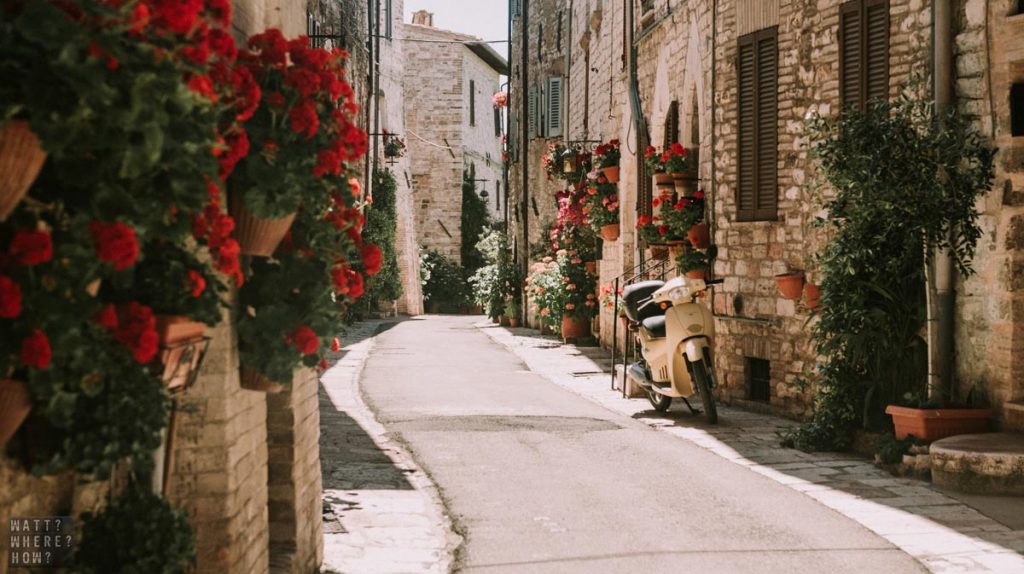
Of all the medieval hilltop towns of Tuscany and Umbria, Assisi Italy offers a sense of peace – even in peak season.
But first a little back story about Assisi, Italy and its most famous figure
OK, this isn’t intentionally written as a religious lecture, but to understand the significance of Assisi, it helps to understand the historical context.
Way back in the 1100s, a wealthy cloth merchant’s son went from party boy to contemplative hermit after having a vision when recuperating from a war injury. Born Giovanni di Pietro di Bernardone in 1182, he was given the nickname, Francesco “the Frenchman” by his father who had a burgeoning import/export business with the French. Around 1202, while still in his teens, this young playboy served in the army that was in an ongoing war with Perugia and he was captured and imprisoned at Collestrada.
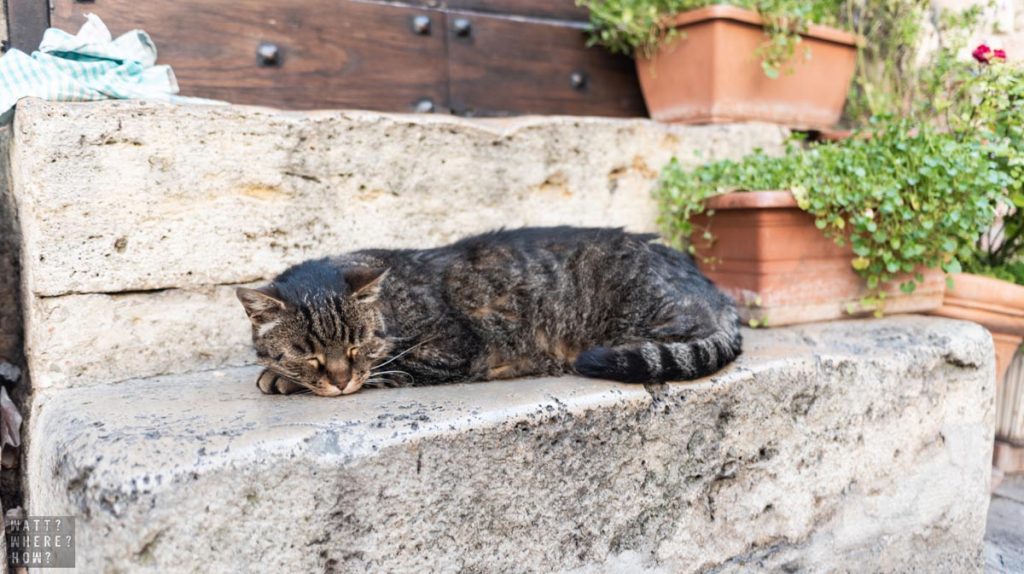
Returning to service with the army of Walter III, Count of Brinne in 1205, he was overcome with vivid spiritual visions and returned to Assisi Italy, where his behavior markedly changed. He avoided his partying ways and after praying in the small local church of San Damiano, he saw the Byzantine crucifix of Christ speak to him, saying “Francis, Francis, go and repair My house which, as you can see, is falling into ruins.”
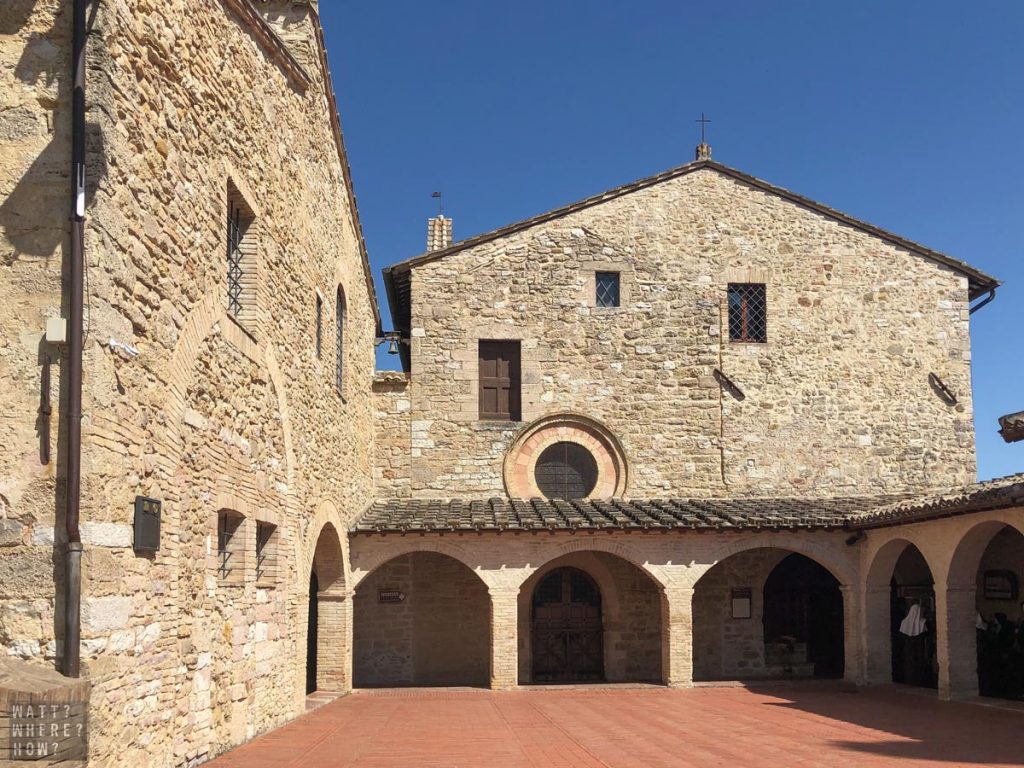
Taking the vision literally, he went back to the merchant business and sold off the ornate cloth to fund the renovations – without his family’s permission. Fearing his father, he hid in a hermitage for a month but eventually returned home to an irate dad who beat him, imprisoned him, and sought restitution for the lost money by asking him to give up his inheritance. To add to the humiliation, his father ordered legal proceedings in front of the Bishop of Assisi and Francis renounced his family and stripped naked to give up anything they owned that was his.
Embracing a life of poverty, he dressed in a rough cloth robe and spent his days praying, preaching, and begging for money to help others. A small core of followers joined him, the Order of Friars Minor (OFM), and after hearing him preach in a local church, a well-to-do noble, Clare (Chiara Offreduccio) joined the order. Together they sought to share their love of nature, peace, and God with the world, traveling from Assisi Italy to the Middle East and Morocco.
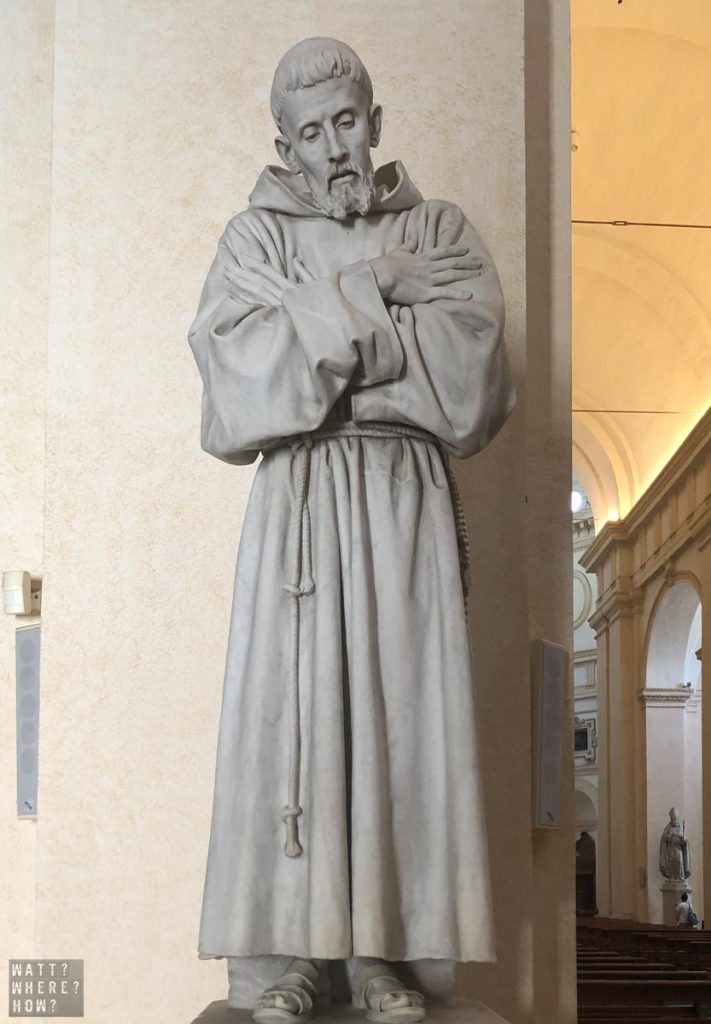
Both Francis and Clare wrote spiritual songs and prayers (including the immortal Canticle of the Sun) and performed a series of miracles. Their followers and church continued to grow to cult-like status, culminating in Francis receiving the Stigmata, a phenomenon where he saw the vision of a six-winged angel on a cross.
He started to bleed from wounds at the point of his body that matched the nails and spear wounds of the crucified Christ. A now ill and injured Francis’ condition continued to deteriorate despite the brothers seeking medical treatment in major Italian cities. He died by the church of the Porciuncula on the 3rd of October 1226 and was declared a saint on the 6th of July 1228 by Pope Gregory IX.
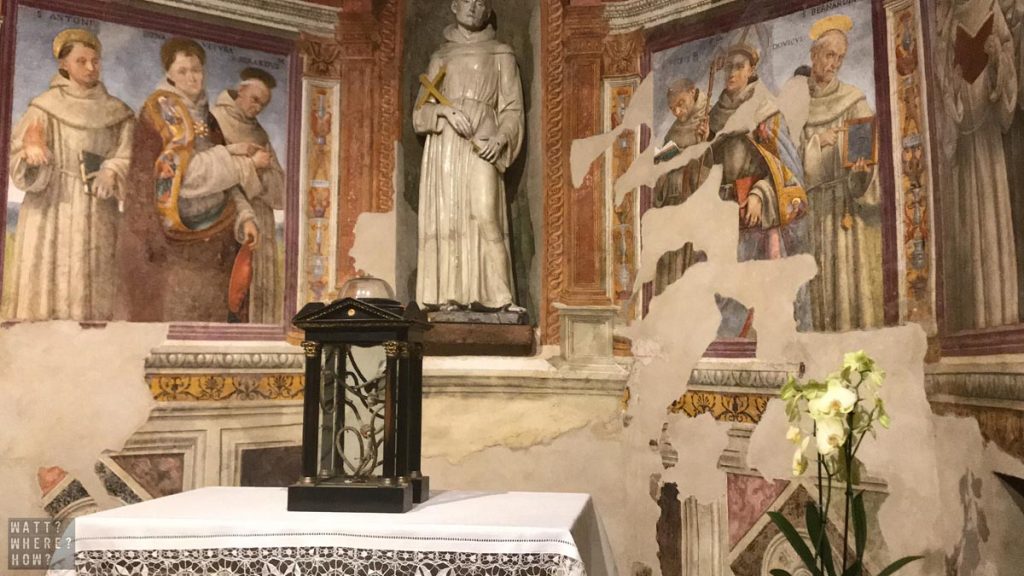
The foundation stone for what would become the Basilica of Saint Francis was laid the next day and the basilica rose up around it, with Francis interred on the 25th of May 1230. He was canonized soon after and his austere teachings inspired a new take on Catholicism in a time where the church was suffering an identity crisis due to embezzlement and corruption.
To this day, Franciscan friars can be found in almost every country and it’s congregation sees Assisi as a must-visit pilgrimage making this UNESCO heritage listed town a major tourist destination for lovers of religion, nature, or history, with many churches and the town’s medieval fortress all in relatively good condition.
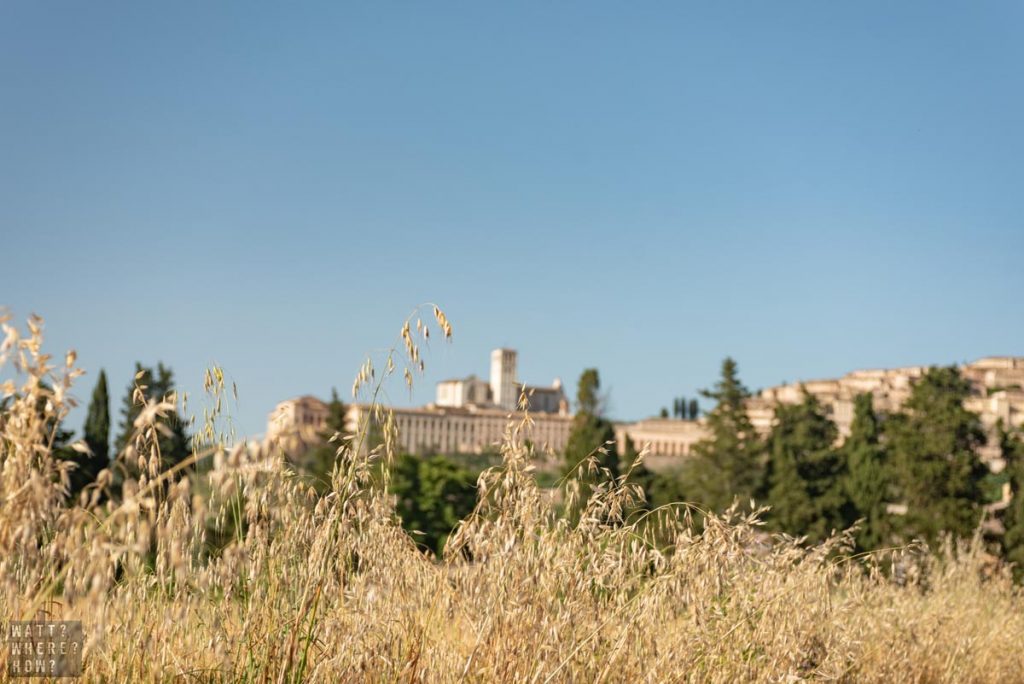
An introduction to Assisi, Italy
Like many hilltop towns across Italy, Assisi is a citadel, a walled town topped with a fortress to defend it. Perched on the side of Mount Subasio overlooking the plains of Umbria, Assisi commands a dominant position, watching out with a 300 degree perspective of any potential invaders. But this town is much older than the middle ages; this is a place dating back to the Etruscans. To this day, the town has a Roman temple and archeologists have also unearthed the original forum which can be visited.
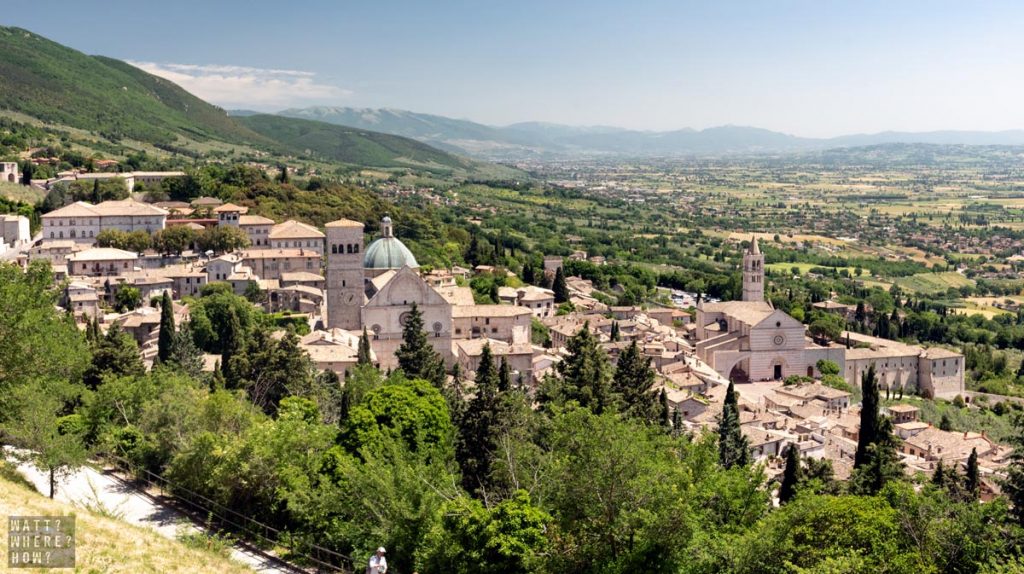
Within the Walls of Assisi
Assisi is protected by a series of gates, the oldest dating back to the 1300s, though the remains of the original walls to be found along the way. Porta San Pietro is the most visible, situated across from the city’s main car park and bus depot, though depending on your explorations, you may come across Porta di San Francesco, Porta San Pietro, Porta Sementone (pedestrians only), Porta Moiano, Porta Nuova (the new gate), Porta dei Cappuccini, Porta Perlic and Porta San Giacomo.
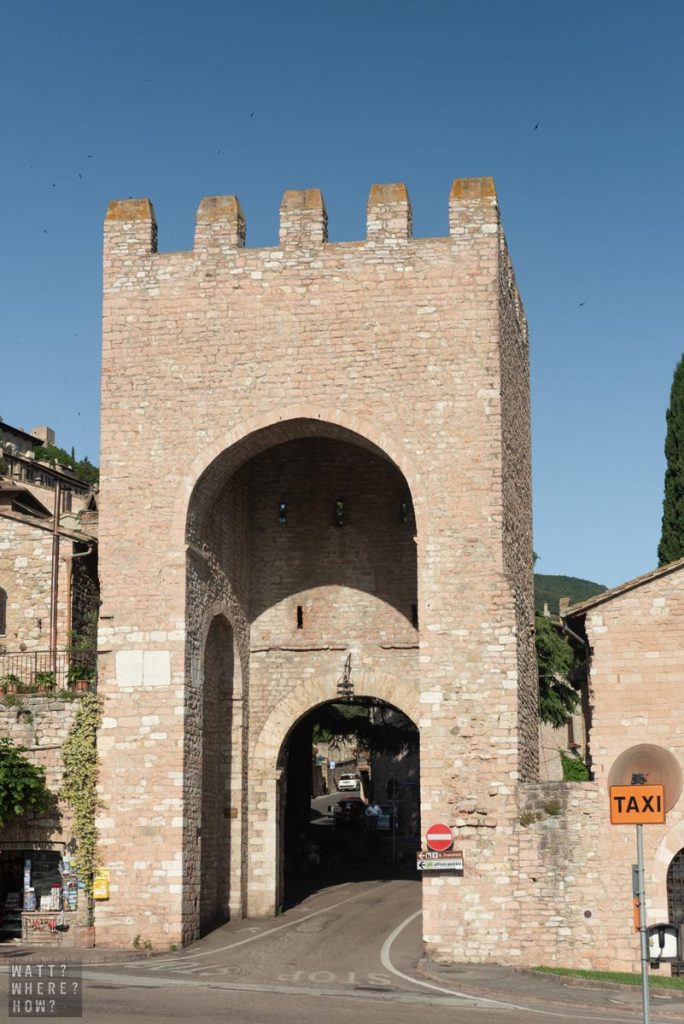
Driving is heavily restricted for good reason – many of the streets are little more than narrow stairs. Despite this, they have an innate ability to make you slow down and live in the moment. Baking under the golden glow of the Umbrian sun, the white, yellow, and rose hues of the cobblestones and stucco will leave an indelible impression on your mind’s eye. Red and pink gerberas blossom out of window boxes in the gentle shade of terracotta roof tiles, which look like they haven’t been replaced since the 1300s.
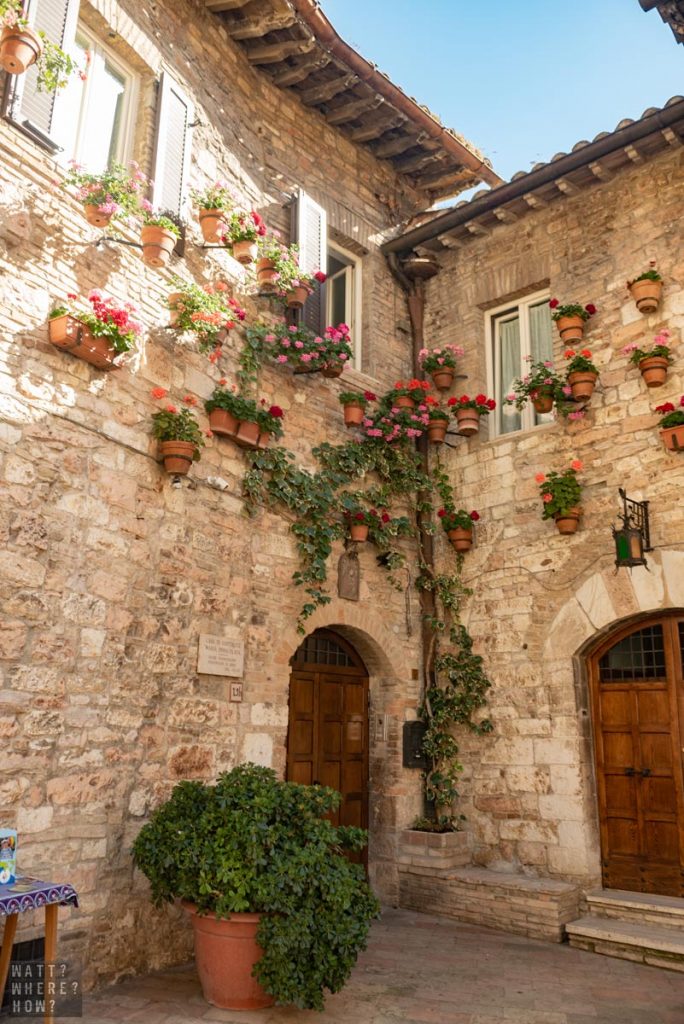
A gradual elevation towards the Rocca Maggiore ensures that you’ll easily make your healthy step count for the day and we recommend conquering the town from the top-down, rather than trying to traverse the slope as the day gets hotter and hotter. With this in mind, we take the local bus up to the highest point of the city, where a modern parking area and shops are tastefully integrated into the existing backdrop. From here, Rocca Magiorre is an easy stroll, though the last section can be a little more challenging for older legs.
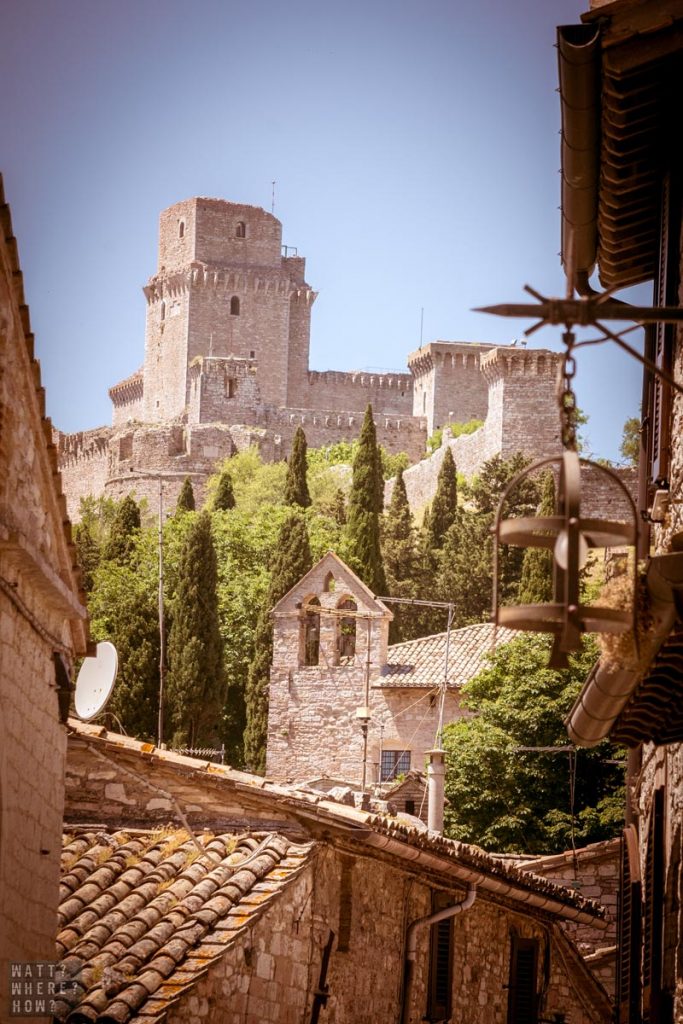
Rocca Maggiore
Assisi was originally protected by two fortresses, Rocca Maggiore and Rocca Minore which watched over the southeast. Rocca Maggiore, the Major Fortress is a 12th-century medieval castle that has watched over the hilltop town of Assisi since 1173, but it’s evolved since the time of St. Francis of Assisi. The future Holy Roman Emperor, Frederick I (Barbarossa) lived in the castle as a child and it suffered extensive damage when it was raided by soldiers of Pope Innocent III.
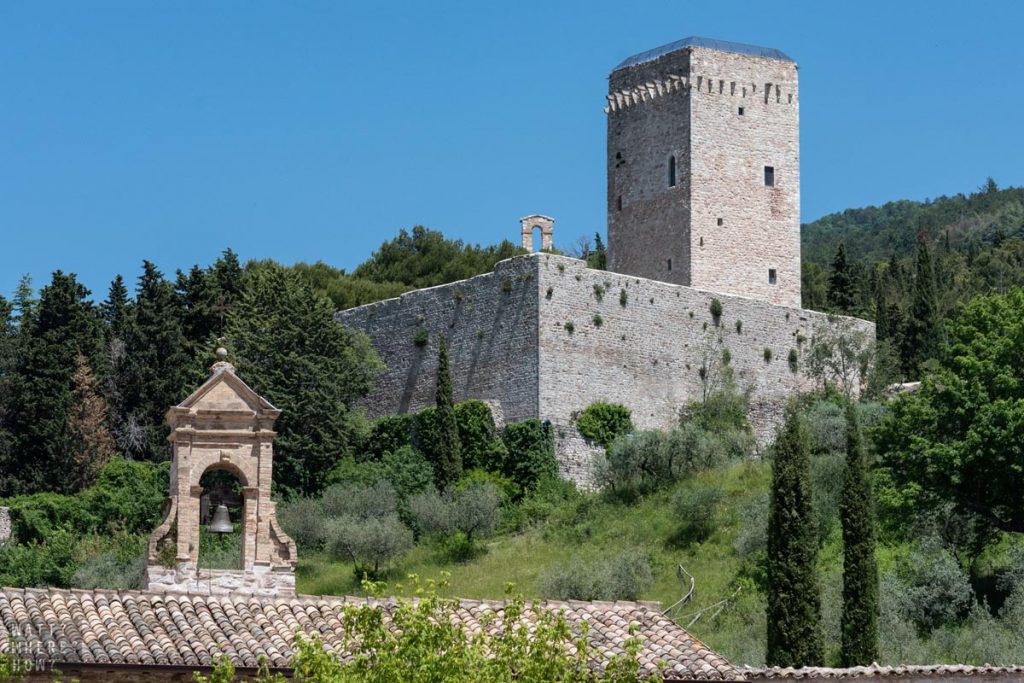
A repair and reconstruction operation in 1356, under the guidance of Cardinal Gil de Albornoz and on behalf of Pope Innocent VI, brought it closer to its current shape as they sought to restore papal authority to the region and the papal keys are visible in stone carvings. This Albornoz-era structure has a central square keep, outer walls, and a hexagonal tower with 360-degree views of the area.
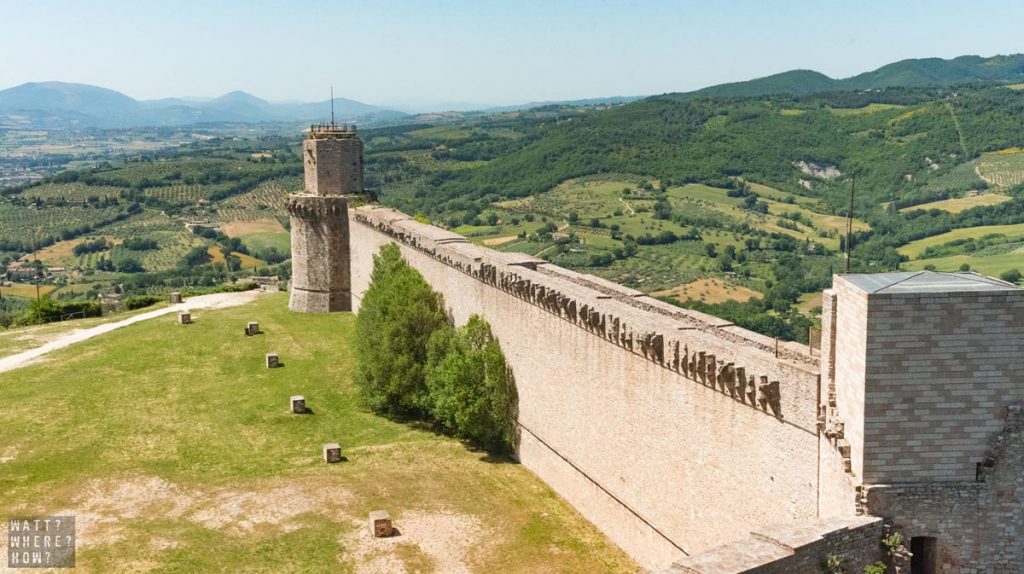
Rocca Maggiore sits abreast of a medieval motte, ensuring it dominates the landscape. The mid-morning dew is slippery and it’s safer to stick to the road than to try to tackle the steep goat track of a path trodden by kids. The thick outer walls give way to a leafy courtyard and there’s a strategically placed cafe that serves ice-cold granitas to satiate the thirst and cool the body down. And you WILL need one. Maybe two.
Pay your six Euro admission and explore inside. The main keep has a small collection of archaeological discoveries and recreations of medieval fashion and you can walk along the walls and look out through the narrow arrow slits, down at the town and valley below. If you don’t mind a scramble, the climb up the tower is rewarded with 360-degree views of the mountain and Umbrian plains. The upper floor houses a collection of medieval and Renaissance musical instruments and photos of the town’s festivities and behind the scenes shots of movies that have been filmed on the site.
Easily the best view in Assisi, Rocca Maggiore is an essential stop for lovers of nature, photography, and history.
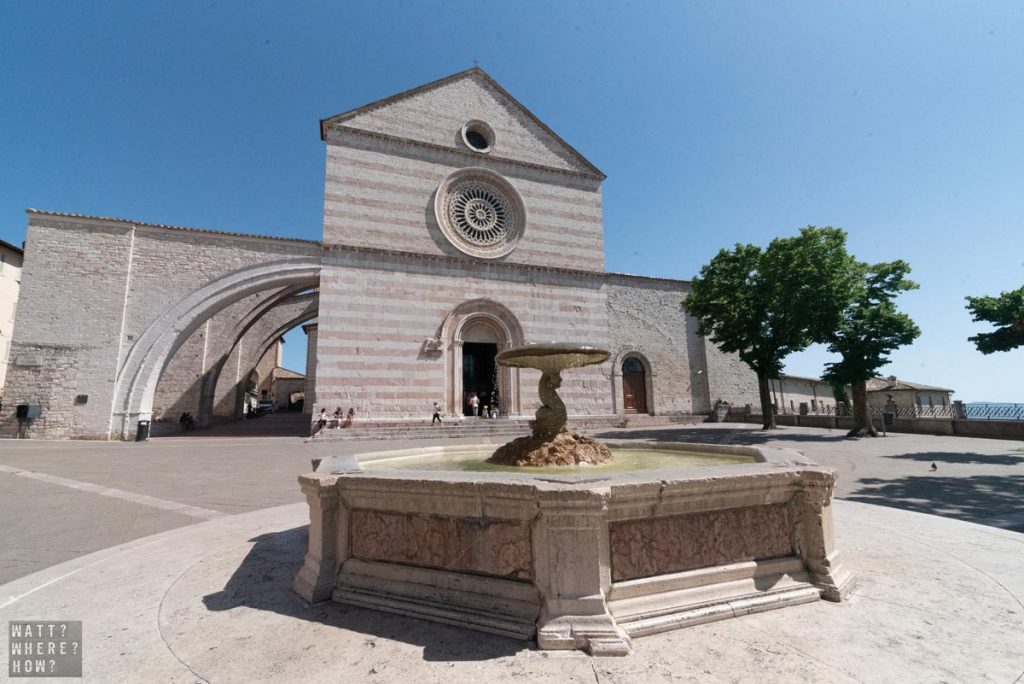
Santa Chiara (St. Clare’s) Basilica di Santa Chiara
A leafy piazza with a large fountain and for tourism’s sake, a carousel greets visitors to the Basilica di Santa Chiara – the Church of St. Clare of the Order of the Poor Ladies. Within lie the bones of the saintly figure who like St. Francis of Assisi, gave up her worldly possessions to serve the sick and impoverished.
The Romanesque structure was built in a time of religious fervor, in 1260, thirty years after the basilica of St. Francis was completed, and to prevent looting, her coffin was hidden within, only to be rediscovered in 1850. Today, her remains are housed in a central crypt beneath the altar, with her earliest loyal sisters including St. Agnes interred in the surrounding walls. At the other end of the crypt, you will find a collection of relics including a casket of St. Clare’s hair and a rough-hewn robe.
Originally the church of San Gregorio stood on this site, and it was here that the body of St. Francis lay from his death at the Porciuncula until the initial shrine of the Basilica was ready in 1230. Adjoining the nave to the south is the Oratorio del Crocifisso (Oratory of the Crucifix), a peaceful chapel that preserves the venerated 12th-century crucifix that spoke to St. Francis at San Damiano just outside Assisi Italy.
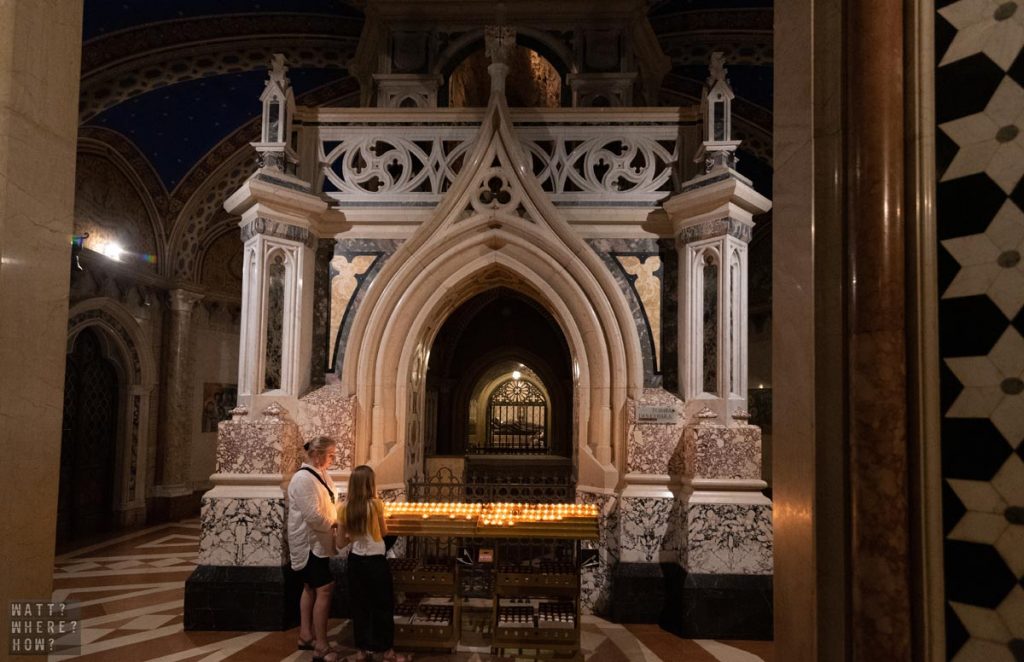
Cathedral San Rufino
Cathedral San Rufino, also known as Assisi Cathedral is the town’s original place of catholic worship, housing the relics of the third-century saint, Rufino, who converted Assisi Italy to religion and who was martyred for his efforts. Within the stonework of the 11th-century church that stands upon earlier manifestation, his bones are buried. The cathedral also stands on what was once the Roman Forum and its foundations can be seen, partially excavated, and preserved under a perspex platform.

As Assisi’s oldest church, built-in 1029, it is the same place in which St. Francis and St. Clare were not only worshippers and preachers, but they were also baptized in the very font that still stands to the right as you enter the church. Protecting the facade are carved stone statues of lions and griffins, symbols of Perugia, though the lions appear to be devouring people – we’re not sure if that stands as an ancient warning.
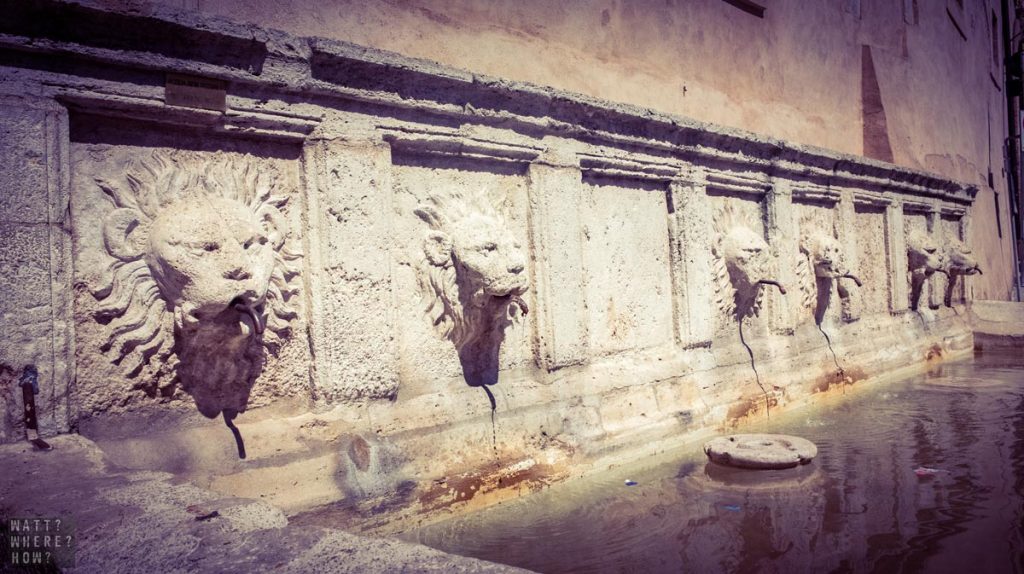
Constructed in the Umbrian Romanesque style, the original clock tower from the 1100s stands strong, alongside the main facade. You can see inside the cathedral, but an additional entry fee into Museo Diocesano e Cripta di San Rufino gives you access to the crypt with its Roman-era sarcophagus, which is said to have held the remains of Saint Rufino.
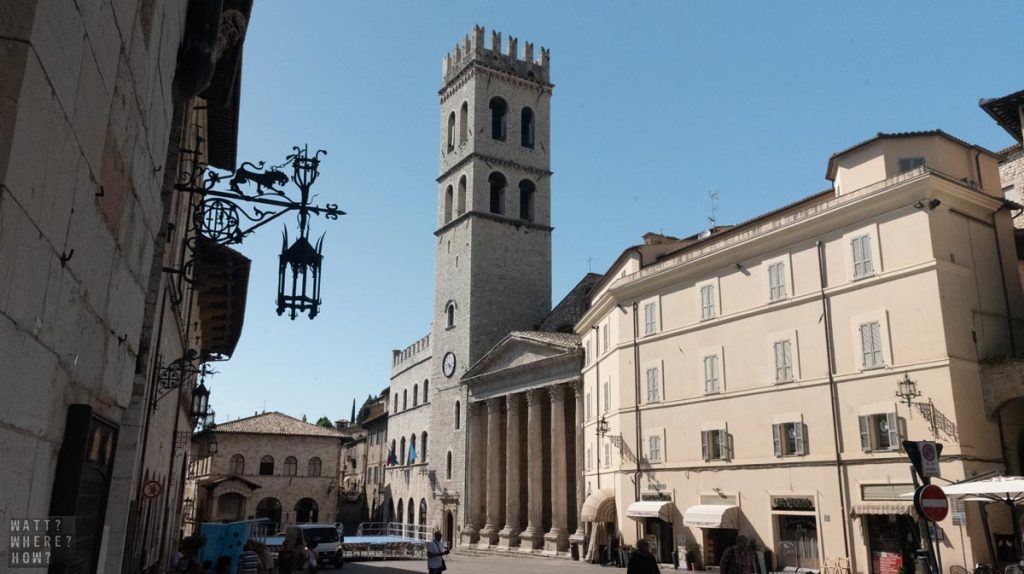
The Piazza del Comune
The Piazza del Comune or town square has been the center of Assisi since before the Roman empire. In fact, the Roman presence is immediately felt, with the Temple of Minerva dominating the piazza.
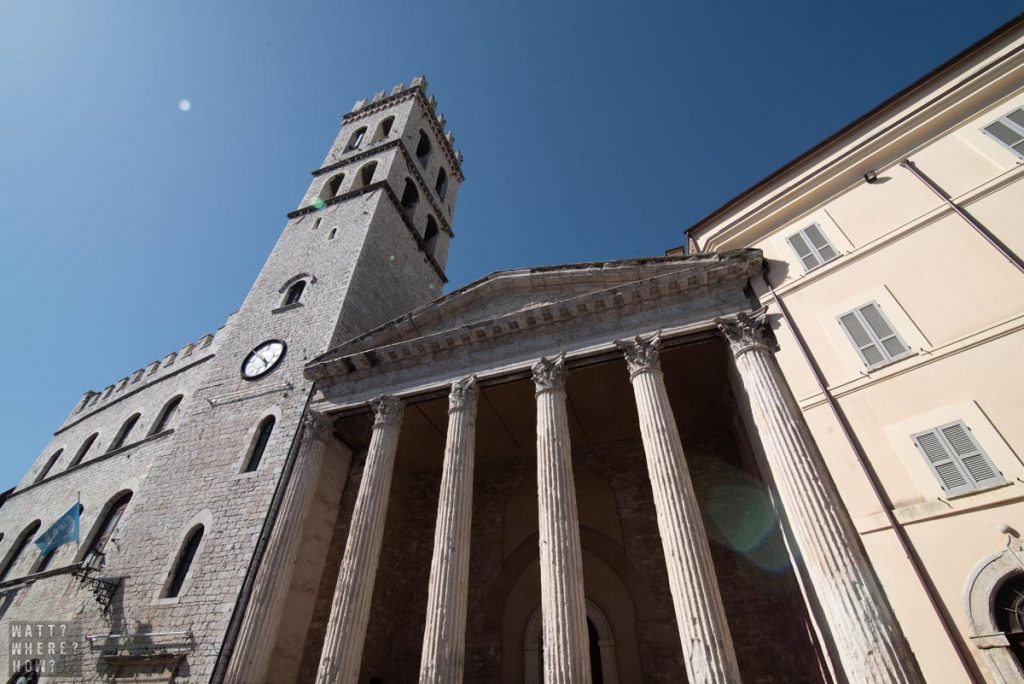
Temple of Minerva
The centerpiece of Assisi’s main piazza is a Roman temple, the Temple of Minerva, built in 1BC. Dedicated to Minerva, queen of wisdom and peace, the temple’s facade and its six Corinthian columns are in remarkably good shape and there are clear inscriptions just inside of the entry. Its presence was enough to entice literary great, Goethe to visit on one of his grand tours and was originally part of an extensive forum, of which some has been rediscovered and now preserved.
The temple’s inner sanctum was repurposed in 1539 when it was transformed into another church – Santa Maria Sopra Minerva (as if Assisi really needed another place of worship). Today’s church is the result of major renovations in the baroque era and its interior is richly ornate. Outside in the Piazza del Comune, an aging fountain brings icy water to the square, while the tower of the town hall watches over the town authoritatively.
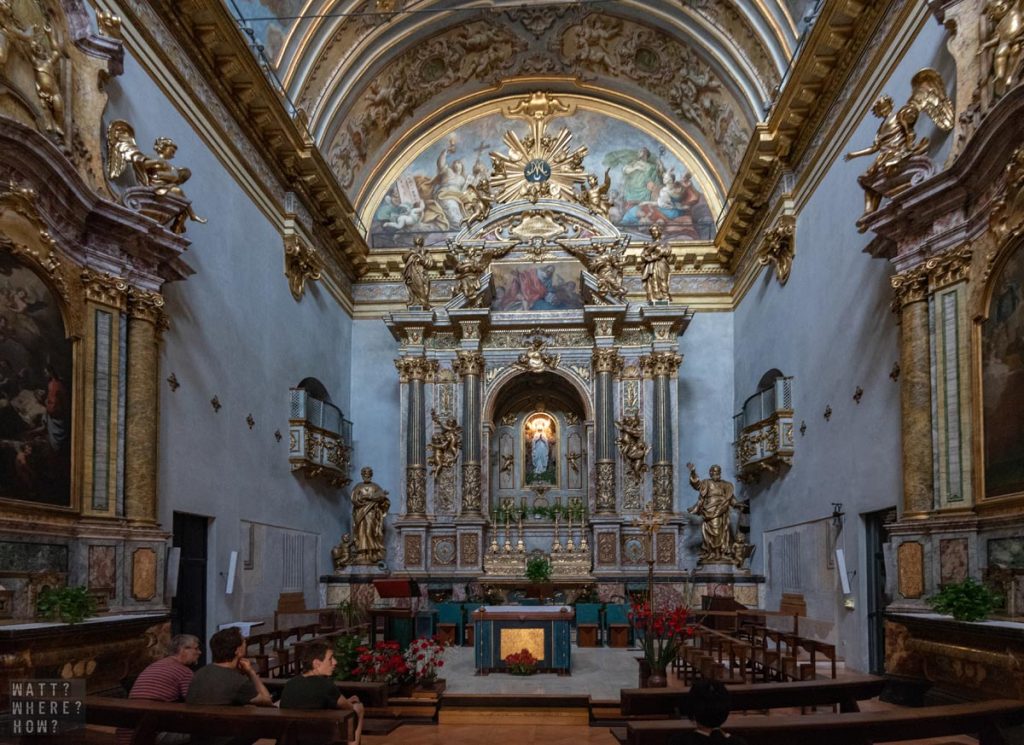
Shopping
With Assisi’s prominence as a pilgrim destination, most of the town’s shops are devoted to religious tokens and paraphernalia. Nearly every shop on the major thoroughfares shares a common theme of crucifixes, rosary beads, and tau crosses. Others focus on medieval kitsch and renaissance regalia. For some bizarre reason, Harry Potter merchandise is dominant, regardless of the piety of the retailer – there’s some strange connection between JK Rowling’s secular creation and Assisi that we just can’t see. It’s a little weird.
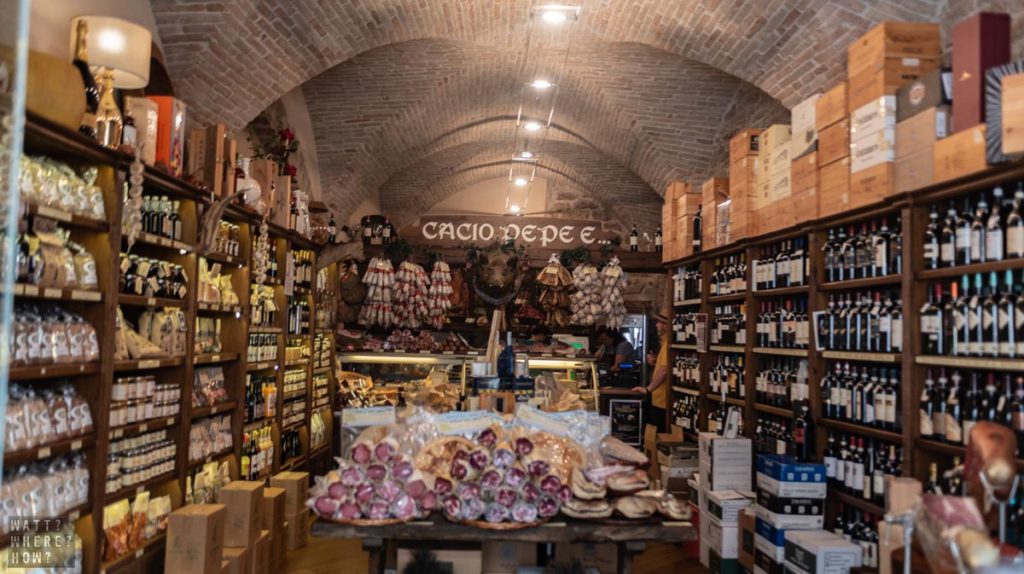
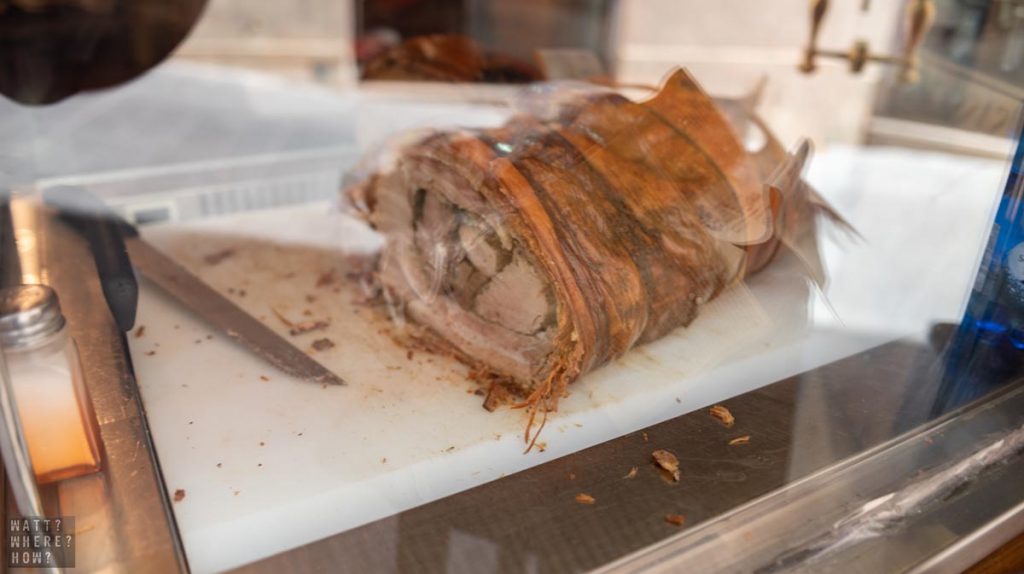
For those not hunting religious ephemera, there are plenty of enticing food shops. The town has its own famed bread, along with preserved wild boar meat sausage, truffles, extra virgin olive oil, and wine. Like most tourist hot spots, there is no shortage of restaurants with English language tourist menus, however, most of these are average in quality and higher in price than where the locals dine. You will also find plenty of tempting gelatos.
Outside the Walls of Assisi, Italy
Basilica di San Francesco
The Basilica di San Francesco dominates the sightlines of Assisi Italy from below and has dominated the itineraries of most pilgrims for the last 800 years. Perched on the side of the hill, it was built outside of the city walls on a place known as the Hill of Hell, where executions took place. It was chosen on the request of St. Francis, who had devoted his life to helping the downtrodden, impoverished, and rejected.
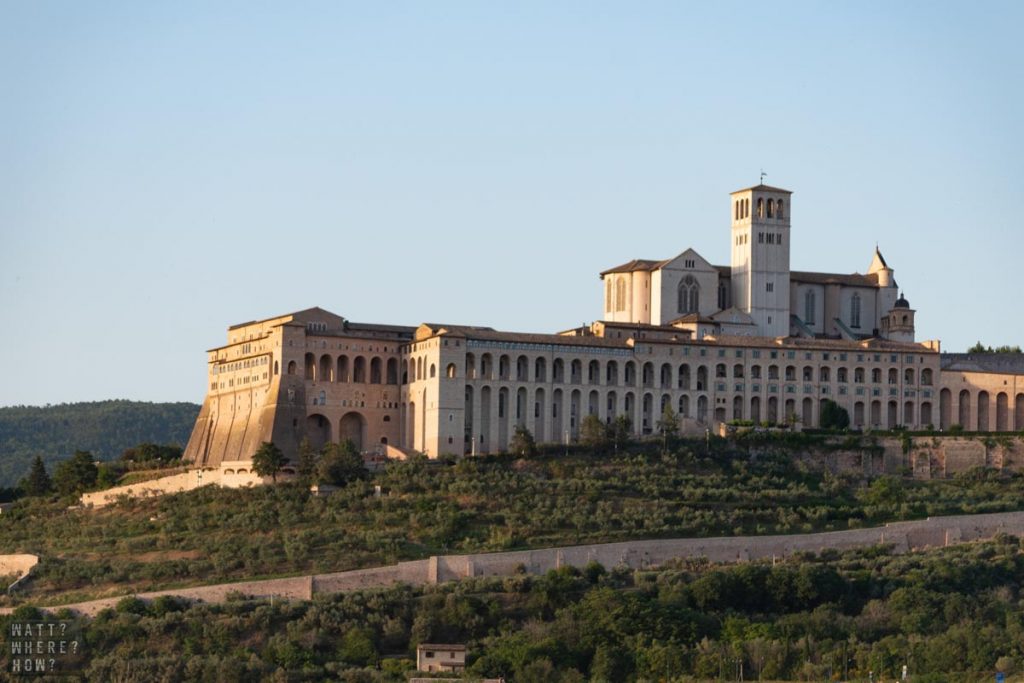
Back in the 1200s, council approvals and red tape appear to have been way more lenient as its construction happened within months of the death of St. Francis of Assisi. After he died at his church, the Porciuncula, his body was kept at San Rufino (AssisiCathedral) until they Basilica was ready and although he was buried within, the specific location was hidden by his fellow friar, Brother Elias kept it a secret until 1818 to reduce the risk of the theft of relics, which were sought after by pilgrims and churches across medieval Europe.
The Basilica consists of three parts: the upper church (the Basilica Superiore), the lower church (the Basilica Inferior), and the main monastery (the Sacre Convento). It is within the lower church where you will find the venerated Cripta di San Francesco, the resting place of the saint.
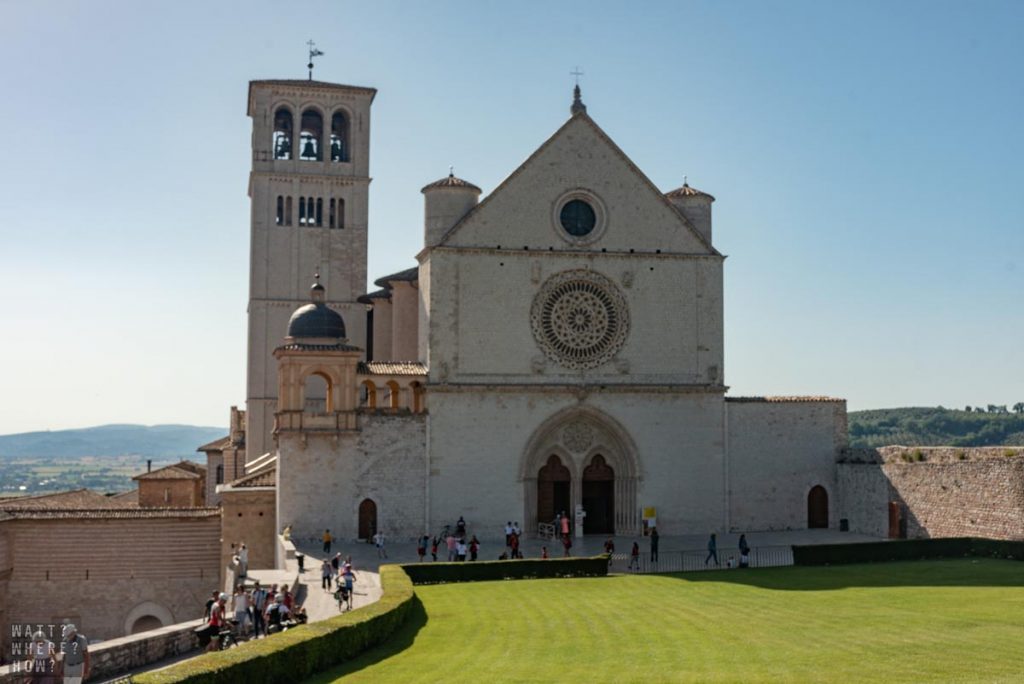
Construction of the Basilica Inferior began in 1228, just two years after he died and the same year he was canonized. With fervor and love for the new saint, some of Italy’s finest renaissance artists contributed to the elaborate frescoes that cover the church and its many chapels. A series of 34 frescoes depict scenes from the old and new testament and for many years, these were attributed to Giotto, though art historians now tend to believe that they are the product of several different hands, possibly under the direction of the master. Just the scenes of Isaac are thought to be by Giotto and painted between 1290-95.
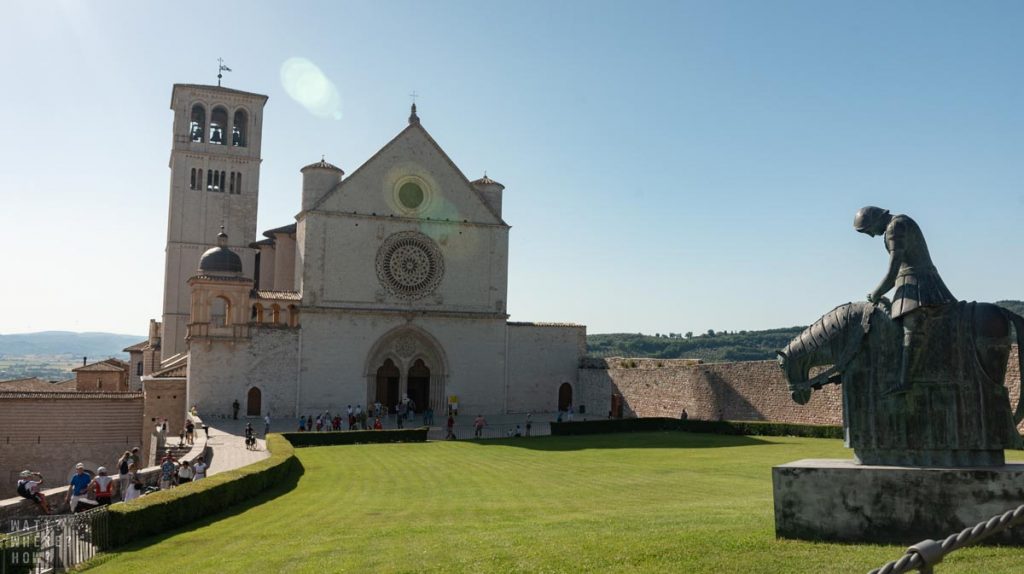
The crypt of today was added and redesigned between the mid-1800s and the 1930s and today, his closest brethren are entombed around it – Brother Leo, Brother Rufino, Brother Angelo, and Brother Masseo.
The Basilica Superiore is almost a mirror image of the Basilica Inferior, built later in 1258. Its key difference is a 28-cycle fresco depicting the life of St Francis, also attributed to Giotto and his school.
The Sacre Convento, built around the time of the main basilica is where visiting Franciscans have studied and lived from the middle ages. Its 53 Romanesque arches create an imposing facade, that house a large number of small, austere cells. These were hospices and a place for friars to stay while studying – the monastery had one of the country’s most extensive libraries of manuscripts. The basilica was damaged in an earthquake that hit Assisi Italy in recent years, but has benefitted from ongoing renovations.
San Damiano
A place of quiet contemplation overlooking the plains of Umbria. I still harbor fond memories of spending a night camping in a tent beneath the olive groves not far from here. It was gloriously peaceful gazing out at the sweeping Italian vista like the statue of St Francis sitting cross-legged gazing off in the distance.
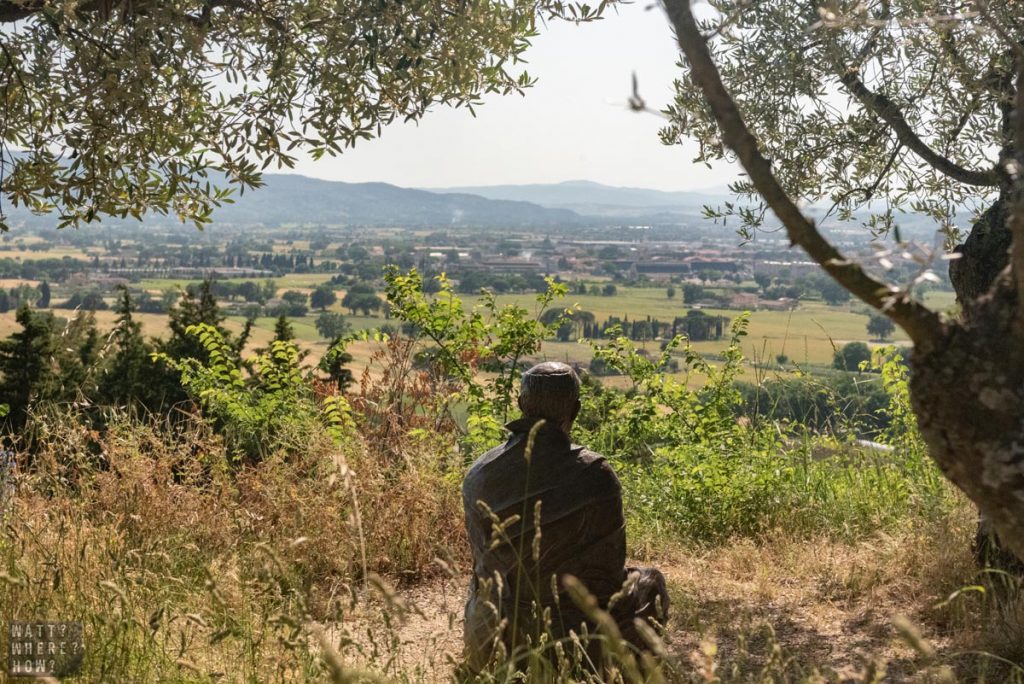
Francis didn’t build San Damiano but it’s where much of his story played out. It was the church where he sought to help rebuild by selling off his father’s cloth and hurling the gold at the priest in frustration when he refused his help. And it’s where according to the many stories that blur the lines between myths, parables, and historic recollection intersect.
It’s also where an ornate Byzantine-style crucifix came to life. The crucifix inside San Damiano is a replica but the real one hangs in a secondary chapel within the basilica of Santa Chiara.
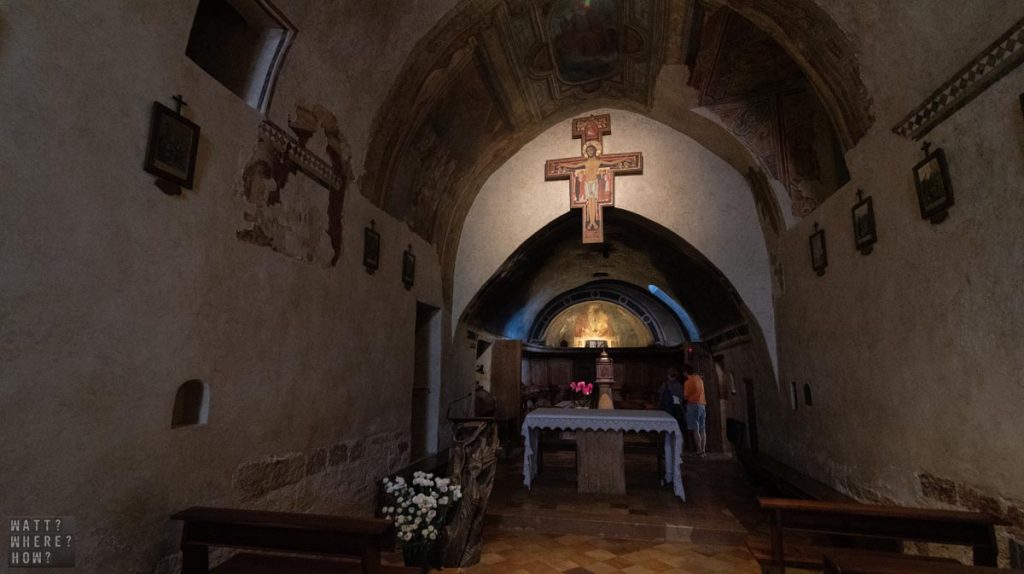
The church itself is much larger than one would imagine, humble in its design yet expanded over time to include two separate cloisters. You approach it from the town either by foot or cab with a procession of nuns indicating where you should be heading. They’re boisterous like schoolgirls and thrilled to have seen one of their religion’s most sacred sites.
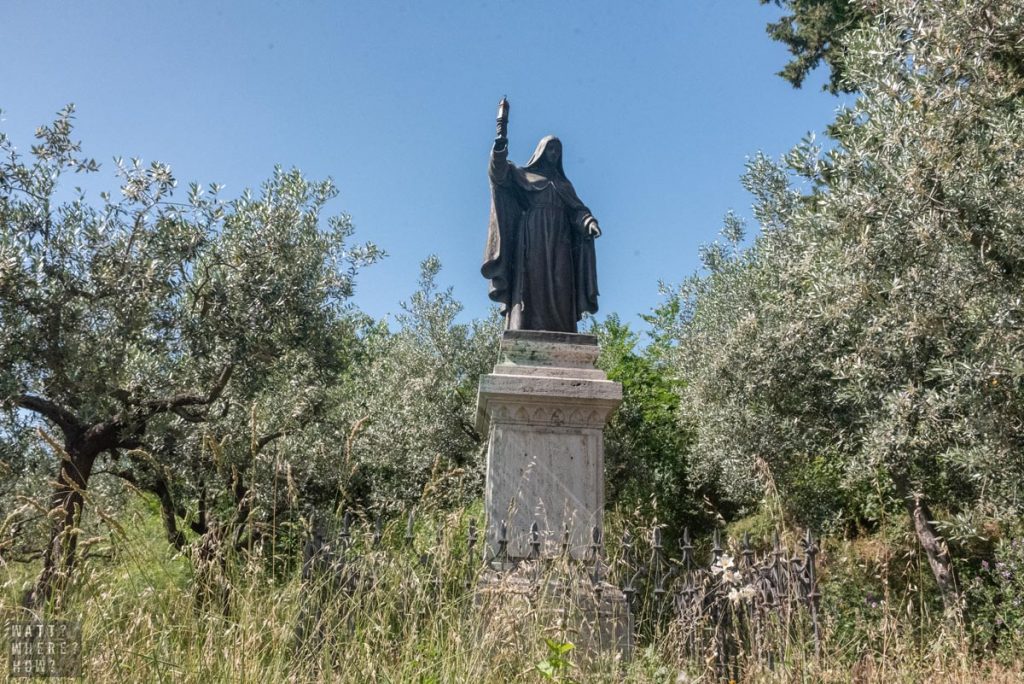
Apparently, their exuberance is too much for such a significant site and a priest issues a lengthy series of admonishing shoooshes shhhhhhhhhh shhhhhhhhhhhhhh shhhhhhhhhh over a very loud speaker system, completely out-blasting their giggles and momentarily removing any vestige of serenity from the situation. It’s quite comical, and soon it’s not just the nuns laughing, though it’s all done in a subdued nature to avoid further noise pollution from the overzealous zealot.
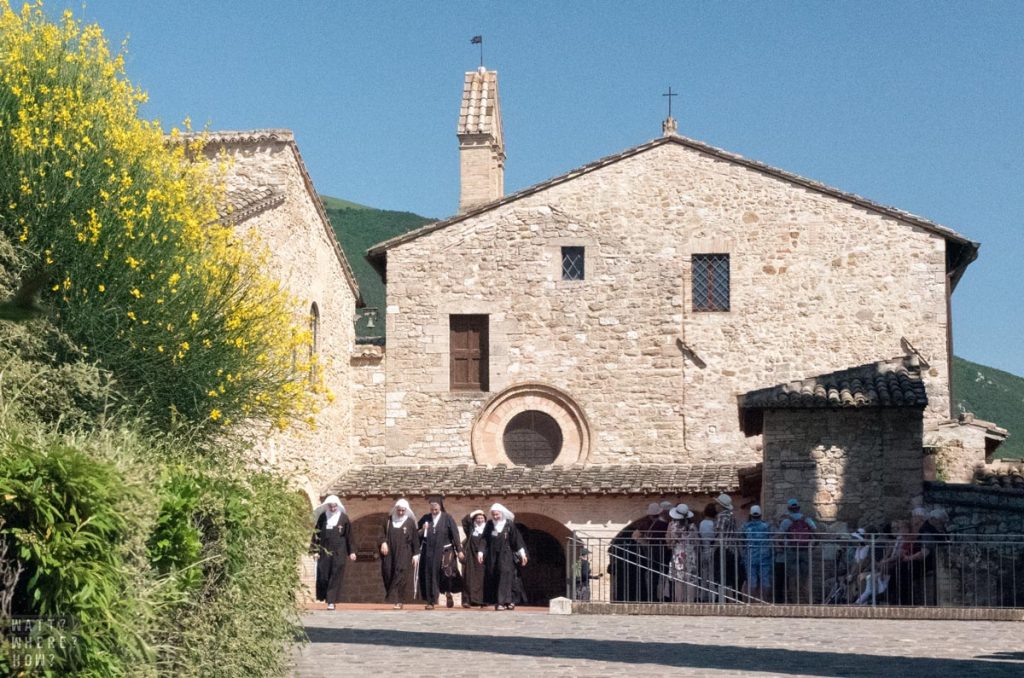
Walking through the church, you pass through ancient chapels, where the friars would sing their praises, canticles, and psalms from rough-hewn wooden music stands, built to hold the thick volumes of illuminated vellum manuscripts. In another room, there is a dedication to Saint Clare, where she breathed her final breath.
The church has evolved over time to incorporate a glorious cloister with an ancient stone fountain and colorful flowers that add to the feeling of peace. Some of the upper floors house simple museums, with one devoted to St. Francis’s most famous and beloved work, the Canticle of the Sun and Moon.
Stepping back outside, take a moment to breathe in the aromas of the gnarled old olive trees and herbal ground cover, listen to the industrious buzz of the bees and look out over the plains below. St. Francis was the patron saint of animals and the environment and right here you can really see and feel why. Assisi Italy holds a magic that can’t be explained, but can be felt.
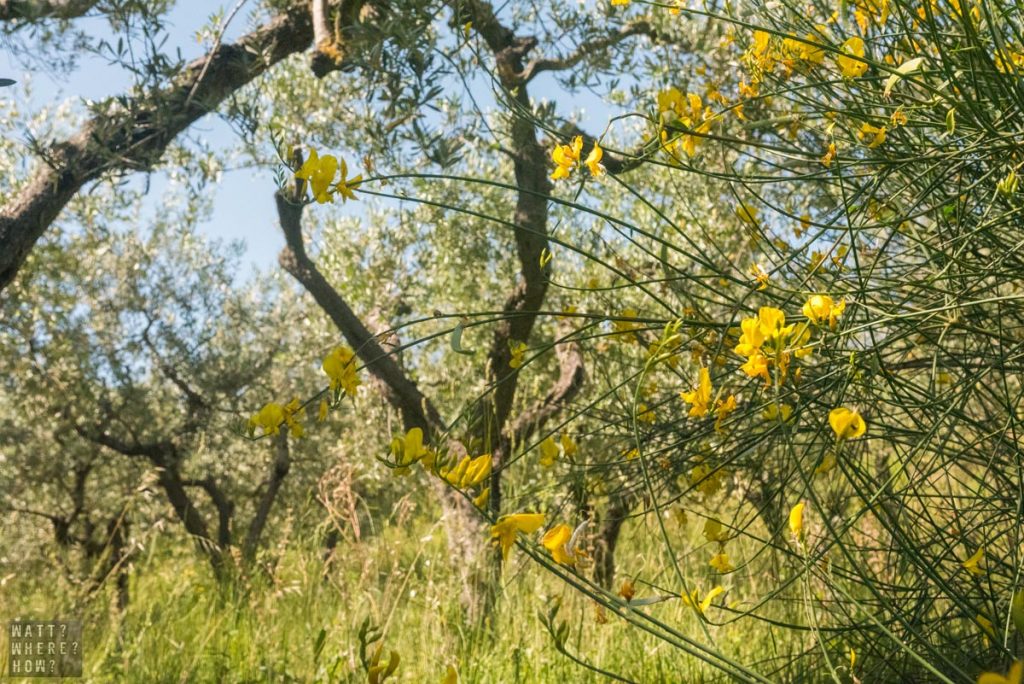
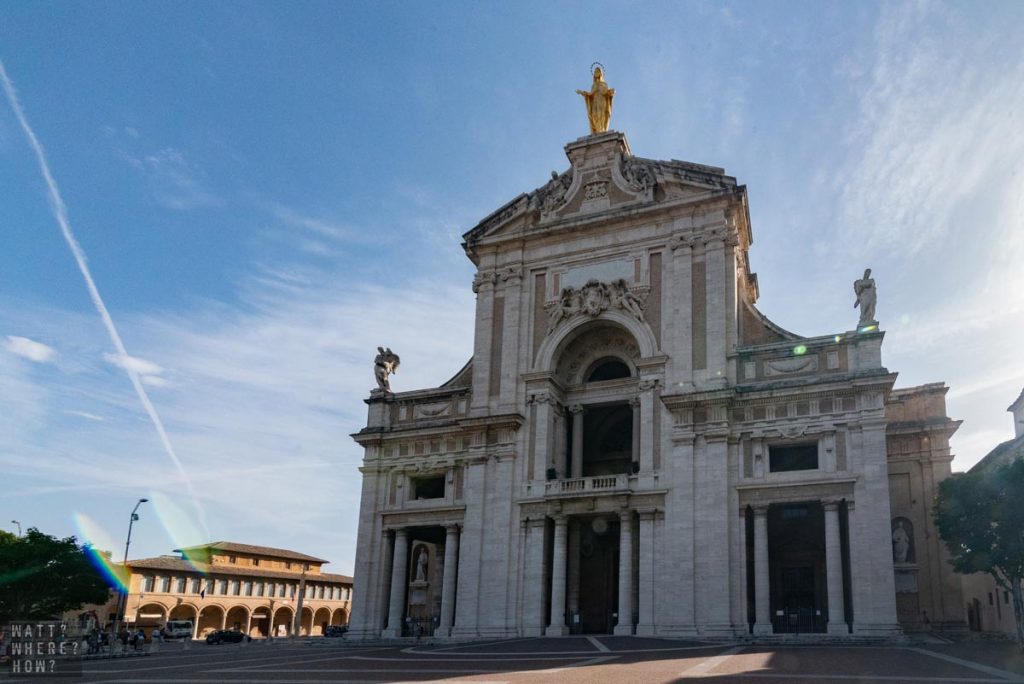
Santa Maria degli Angeli
A natural extension to Assisi, this newer community is a mishmash of architectural styles from different centuries. Set on the flat plains looking up at Mount Subasio, this area is more like a modern Italian city, with the requisite shops you’ll find in any town – McDonald’s, a weed dispensary, and a SuperConti supermarket. What’s different are the opulent convents and hospices for pilgrims. For them, one of the main attractions on their spiritual journey lies not up on the hillside of Assisi Italy, but within a dramatic basilica of Santa Maria degli Angeli.
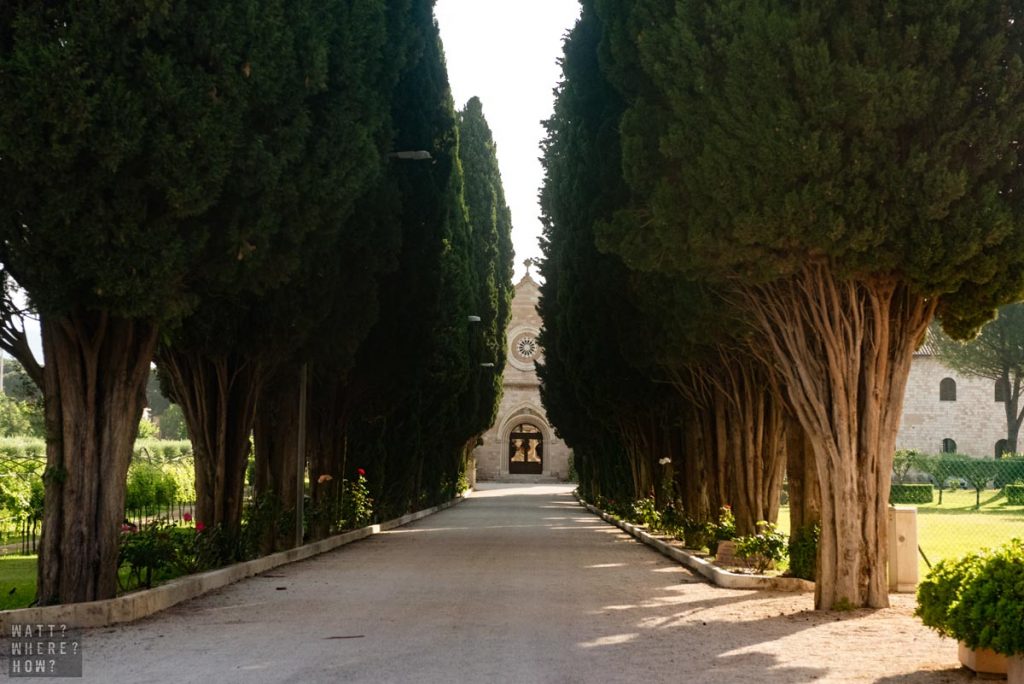
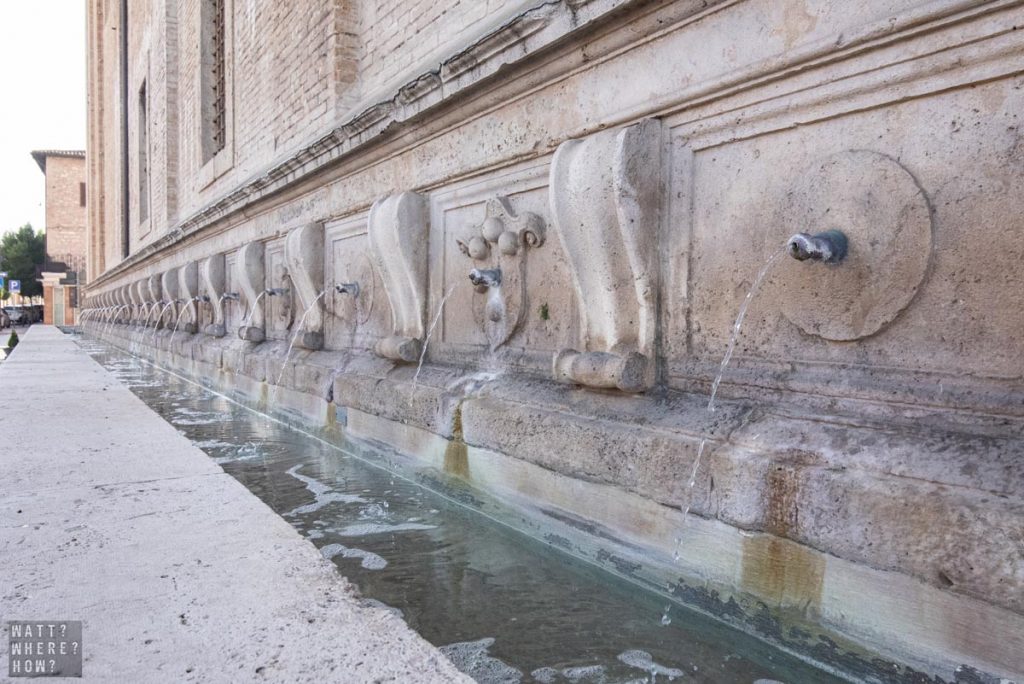
Papal Basilica of Santa Maria degli Angeli
The forecourt or piazza is being prepared for the annual feast day with temporary grandstand style bleachers lining the Main Street leading up to the piazza. Although it’s early in the morning and the tourist traffic is sparse, there’s a strong military presence. A Franciscan friar heartily banters with a couple of heavily armed soldiers standing beside an armored Hummer. It’s a strange dichotomy between the peaceful charter of the priests, the serene, spirituality of the place, and the need for military protection in a day and age when lone-wolf terrorists have been attacking soft targets across Europe.
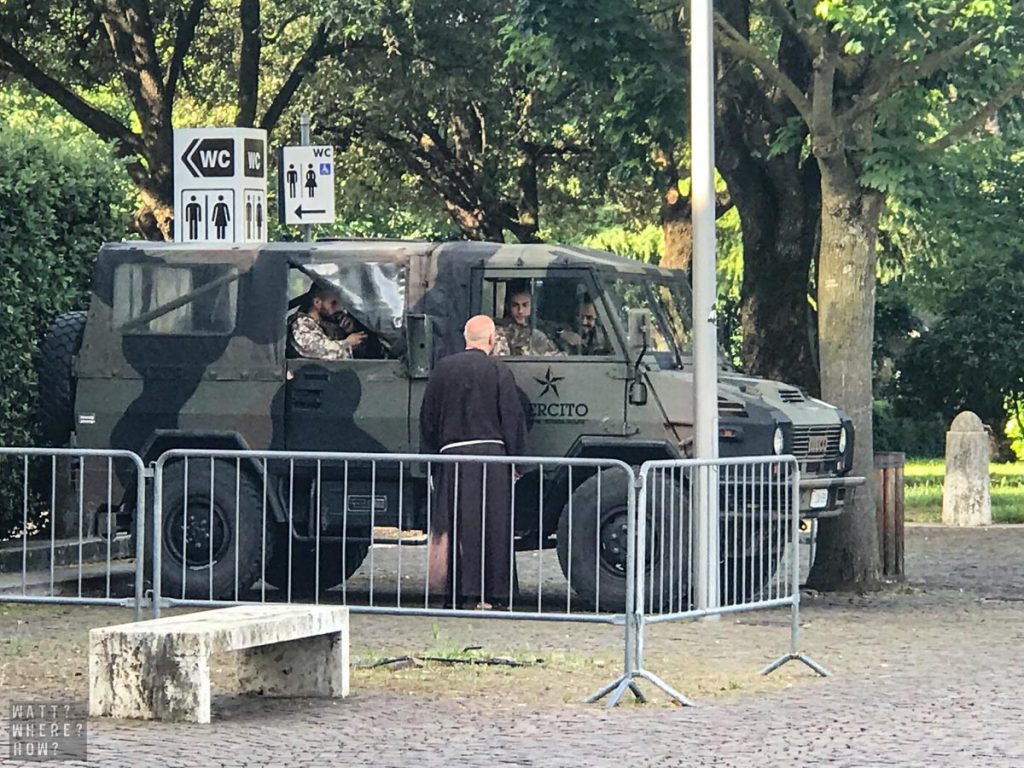
The church of Santa Maria degli Angeli was built in 1569 to protect and offer a place of veneration at one of the Franciscans’ most sacred altars. Up until then, various structures had been built to protect what is the most sacred site for the Franciscan faith and in the 1960s, excavations found evidence of a series of small chapels and stables where Francis’ followers lived. Beneath the grandiose domes and amidst ornate rococo chapels is a humble stone church, the Porciuncola. This simplistic sandstone structure originally built in the 9th century has been embellished over time with beautiful Renaissance oil paintings and a spire that doesn’t quite match the spartan vision of the early friars.
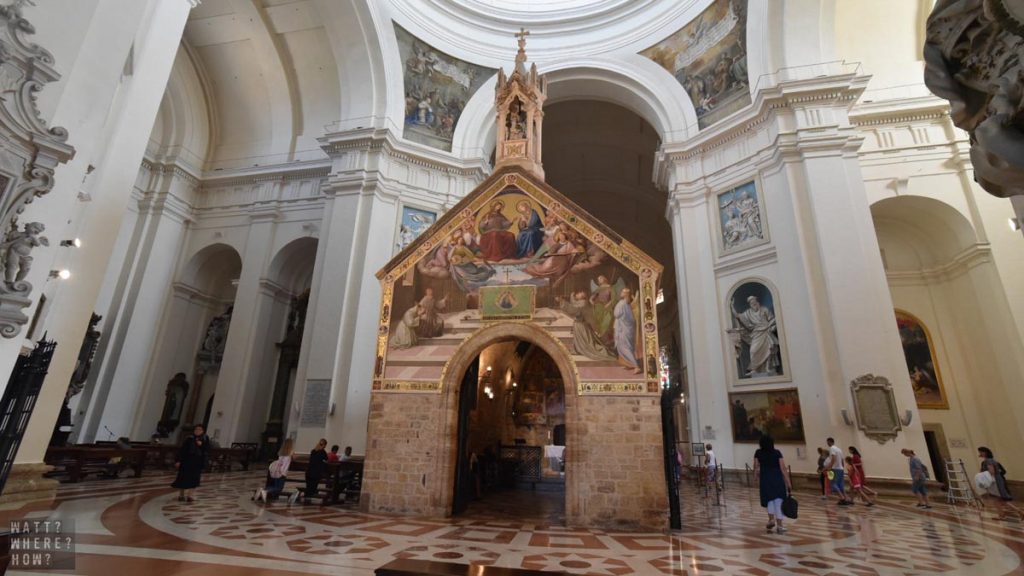
Surrounding it, like the points of a compass is a series of beautiful chapels built in the last few hundred years, but within the austere, candlelit Porciuncula, there’s no fancy masterworks, just a congregation of around twenty pilgrims attending a short service. It’s standing room only and a small crowd gathers outside, fascinated or awe-struck, depending on their beliefs.
Just beyond the old stone church is a small structure which was the infirmary within which Francis of Assisi departed the world. This much venerated place provides a place to stop and contemplate the life of this spiritual leader.
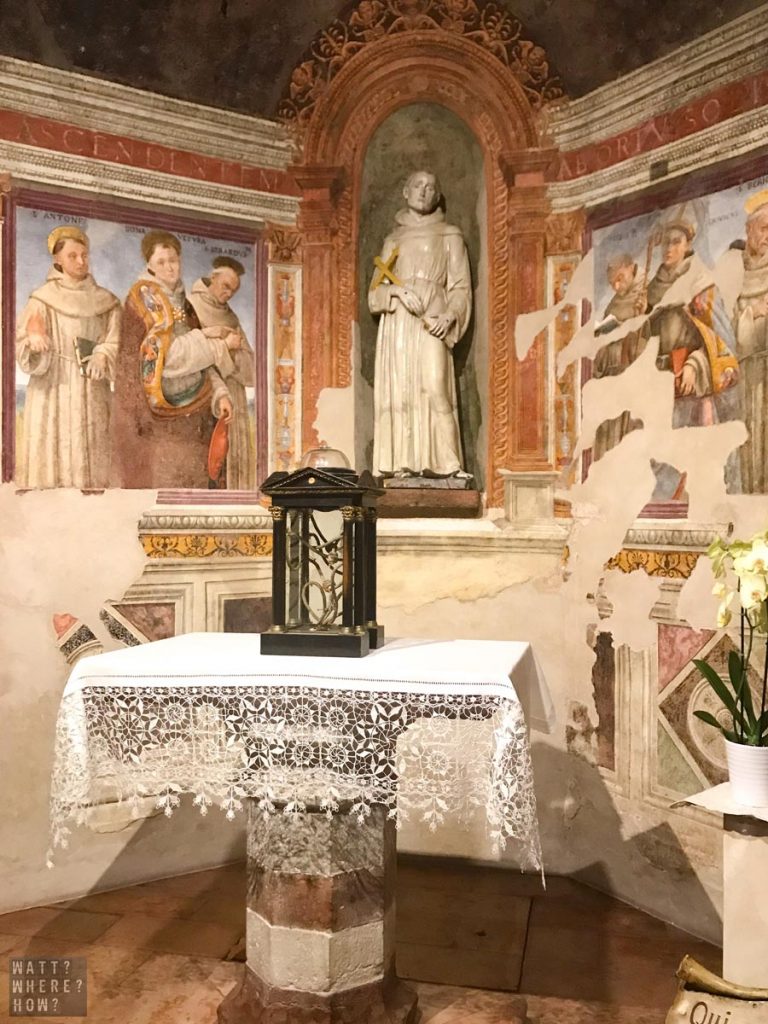
Once the mass is over, we have an opportunity to step inside the beautiful Porciuncula. The interior is refreshingly spartan after the intricacies of the rest of the church. Byzantine-style artworks depict cartoon-like moments from the Bible.
In a secondary cloister, which we first visited back in 1988, is a rose garden with thornless roses, a miracle said to have happened when in a moment of temptation, St. Francis threw himself into the rose thorns as a kind of flagellation – with the roses never again growing thorns.
WHERE TO STAY IN ASSISI, ITALY: IL ROSETTO
Il Rosetto (The Rose) Country House, located on Via Mattonata, within walking distance of Assisi’s train station is a gorgeous example of an agritourismo (farm stay). It’s literally the last block of farmland before the foothills rise up to the historic township and offer large comfortable rooms, home-cooked gourmet meals, their own wine, and a spectacular swimming pool. Read our full article about it here.
We have found our happy place in Assisi Italy and Il Rosetto offers the ideal view, price, and dining options that guarantee we will definitely return in the future.
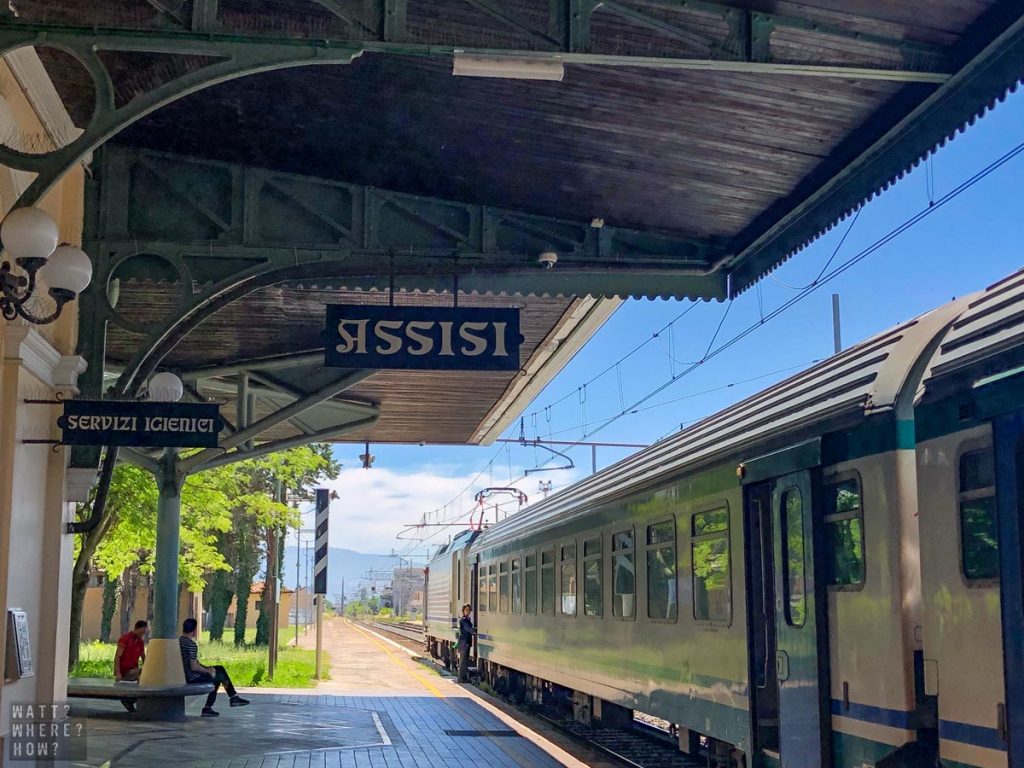
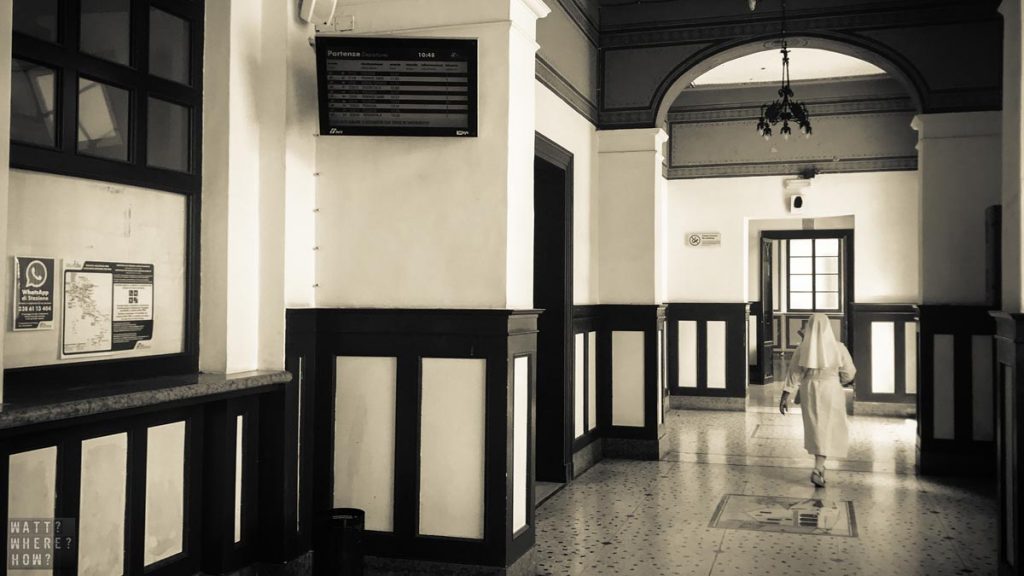

WHAT?
Assisi Italy is a historic township where the Franciscan faith was established. While it attracts pilgrims and believers, it holds plenty of appeal for lovers of art, history, and food.
WHERE?
Assisi Italy is a peaceful Renaissance hillside town overlooking the plains of Umbria.
HOW?
A quaint two platform station dating back to 1866 is your main point of entry to the area by train, with regular services from Rome and Florence via nearby Puglia. It’s only about a five-minute walk from the station to the basilica of Santa Maria degli Angeli and 3 miles (5 km) to the center of the hilltop Assisi Italy. See why train travel is one of the best ways to experience Italy here.
There is a local bus (marked route C) that takes you up the hill and that stops at the main car park (if you’re driving, no cars are allowed inside the walls but there are a couple of major public car parking areas outside Porta San Pietro that you will have to budget for) and close to Rocca Maggiore. You can purchase tickets for €1.30 from the station newsstand or the driver for €1.50 but you will need the exact change or you will have to forfeit it. There is also a local taxi service for a fixed €15 fare. If you’re feeling eager, you can always walk the “mattonata” path up the hill, but take adequate water to compensate for the heat.
WHERE TO FROM HERE?
Florence | Venice | Sienna | Cinque Terre
Follow & Connect with us

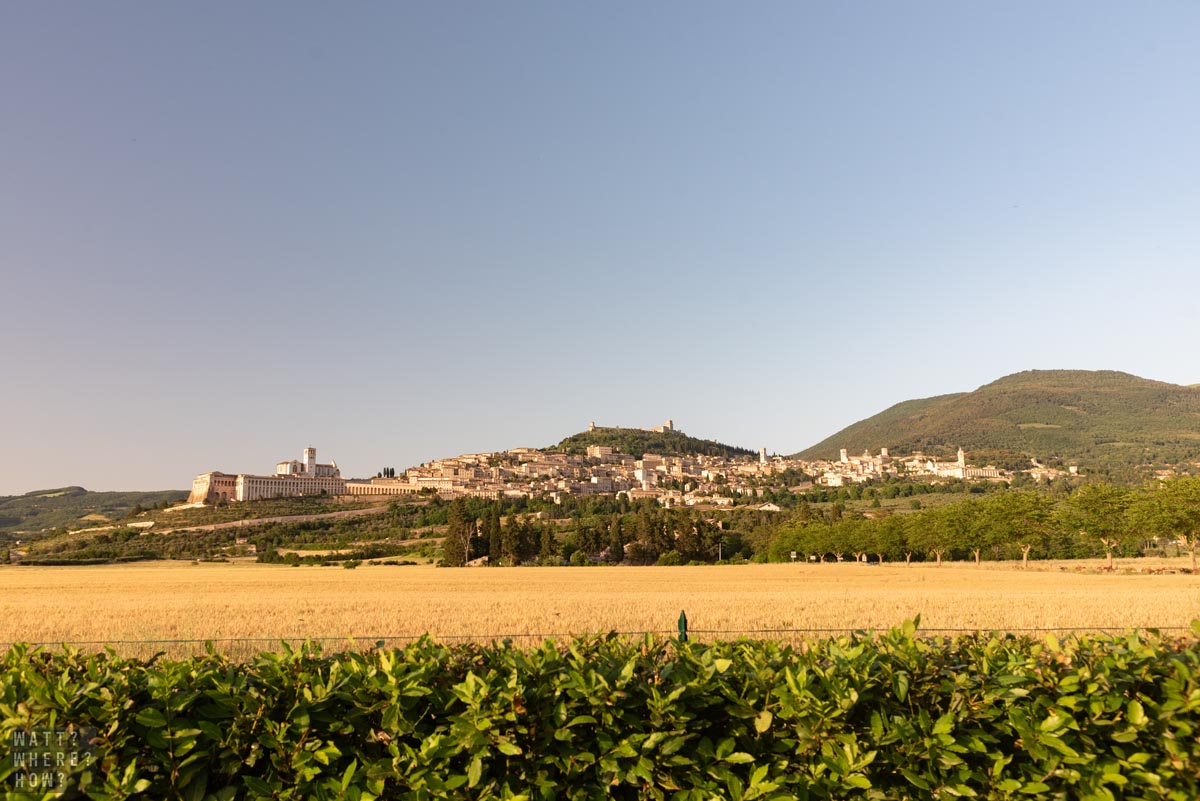
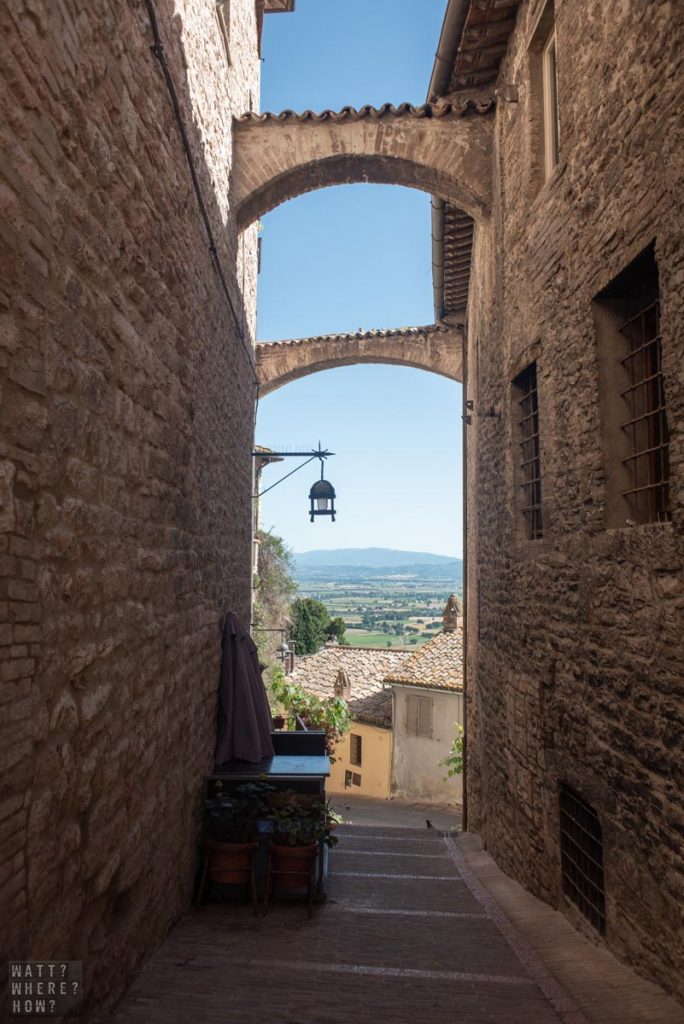
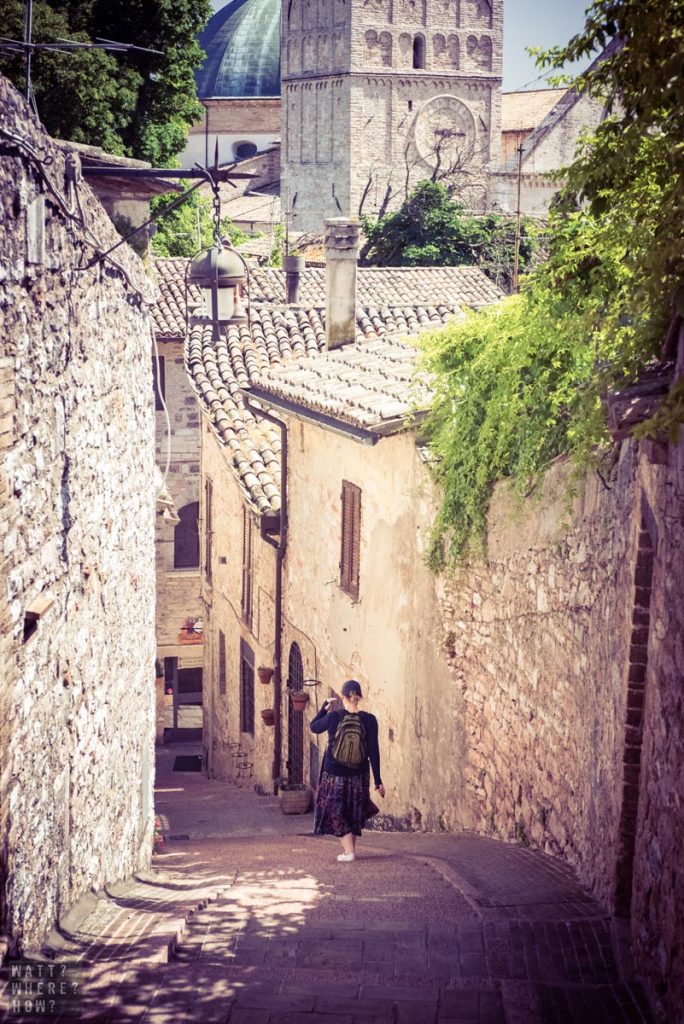
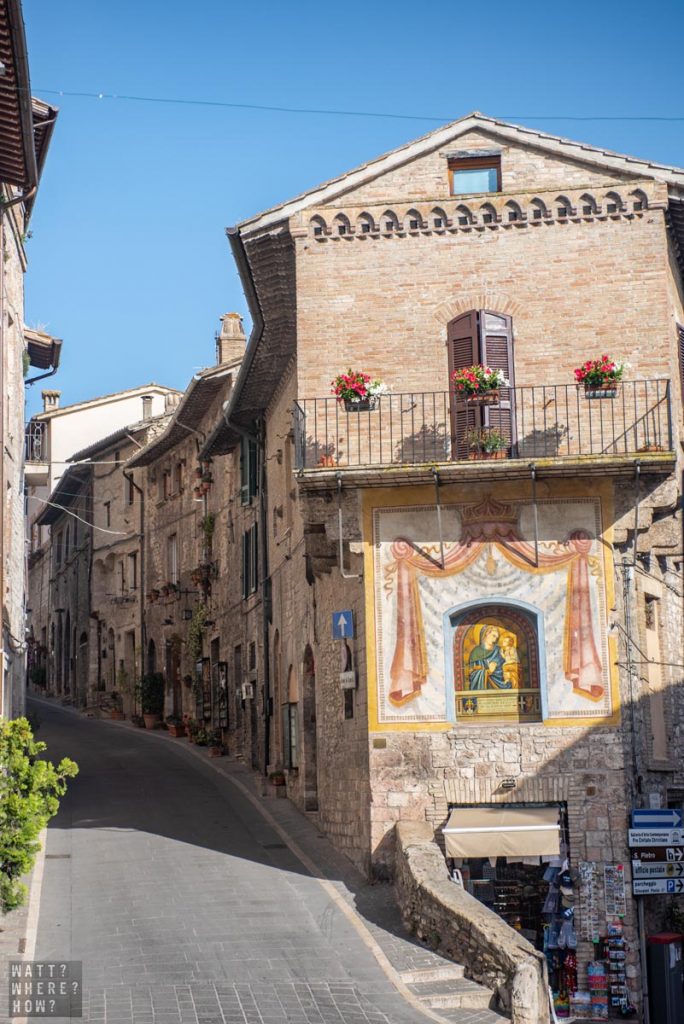
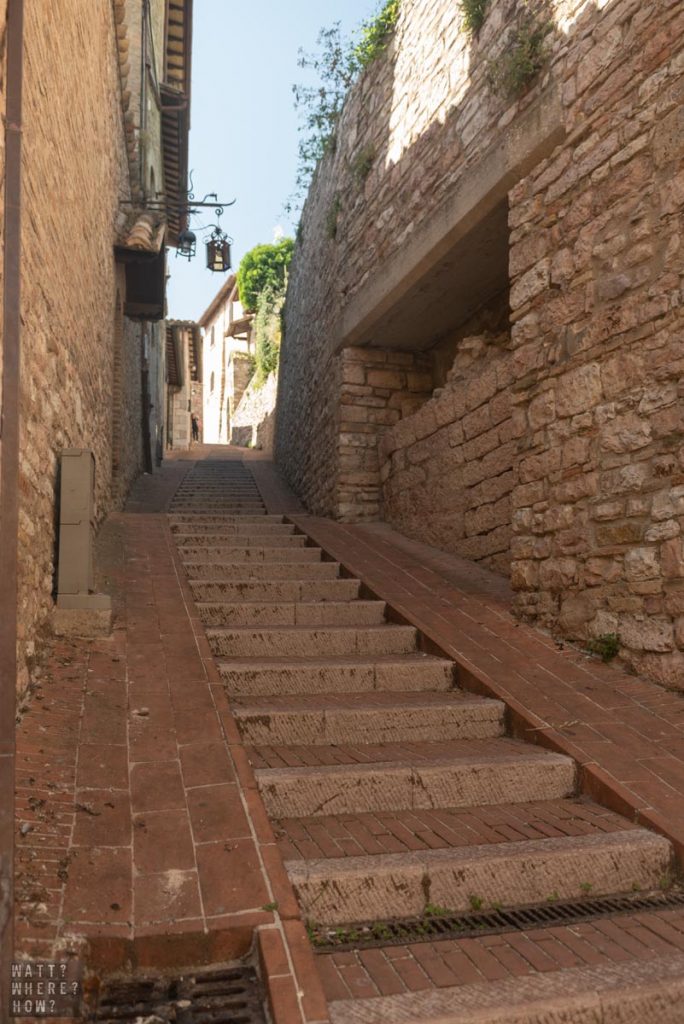
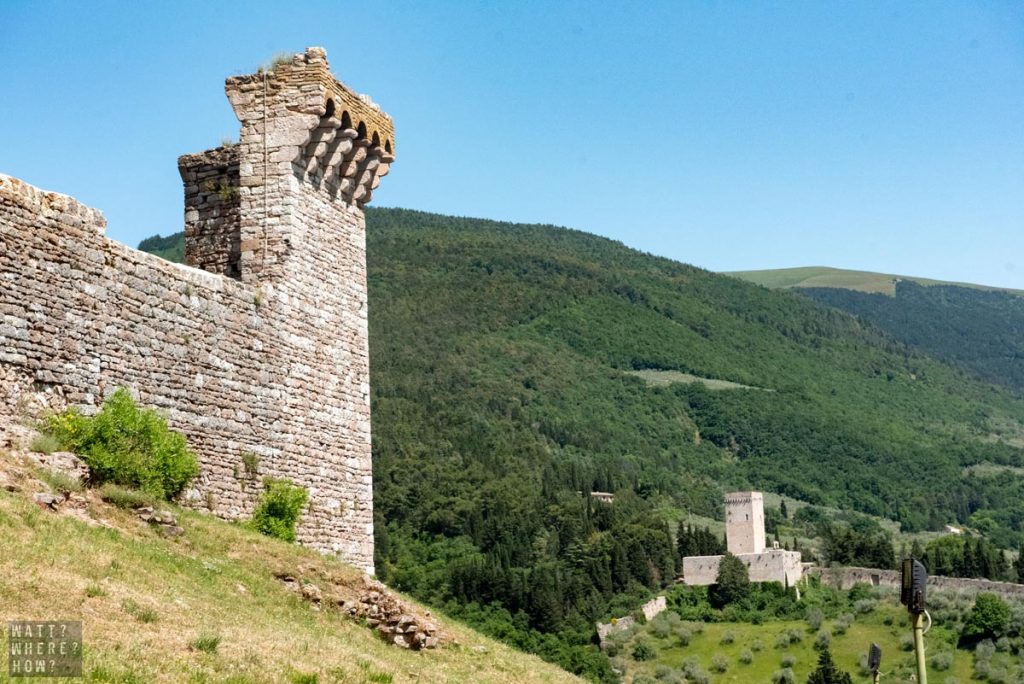
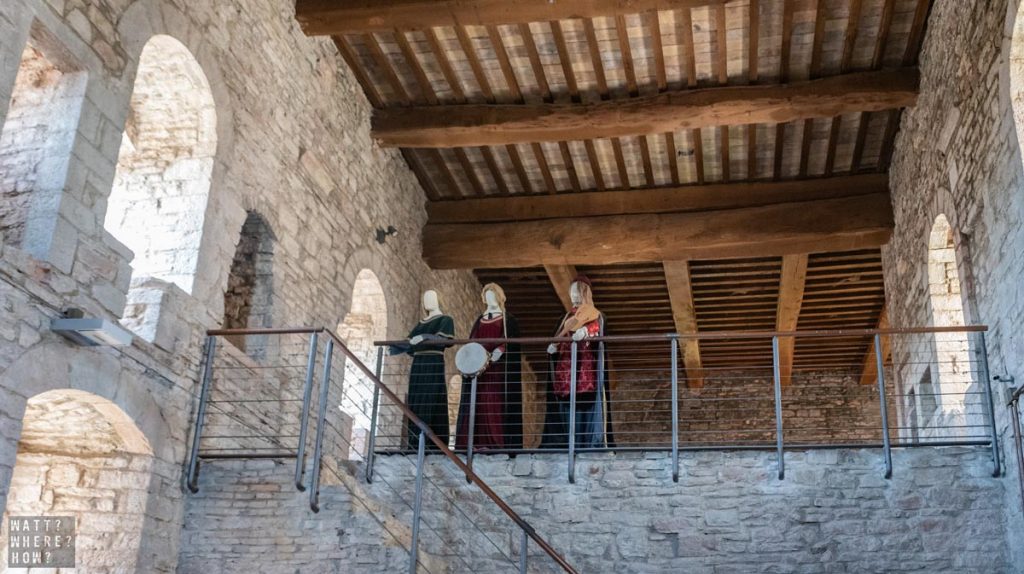
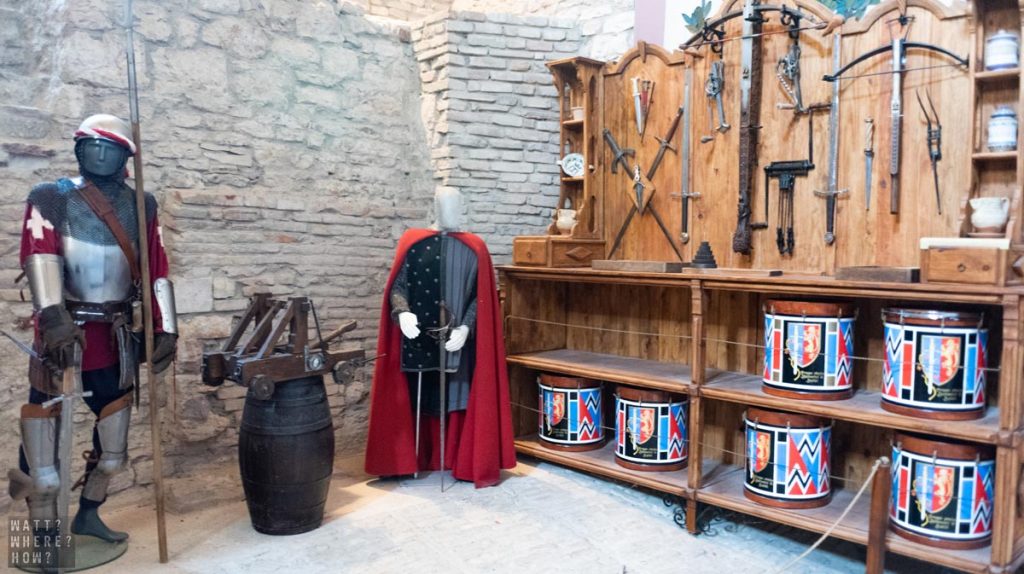
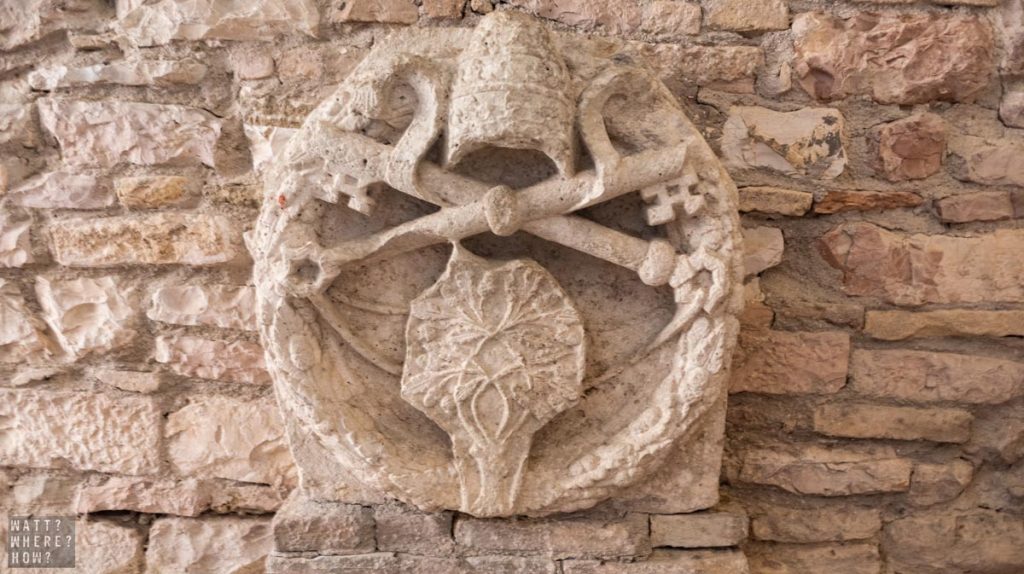
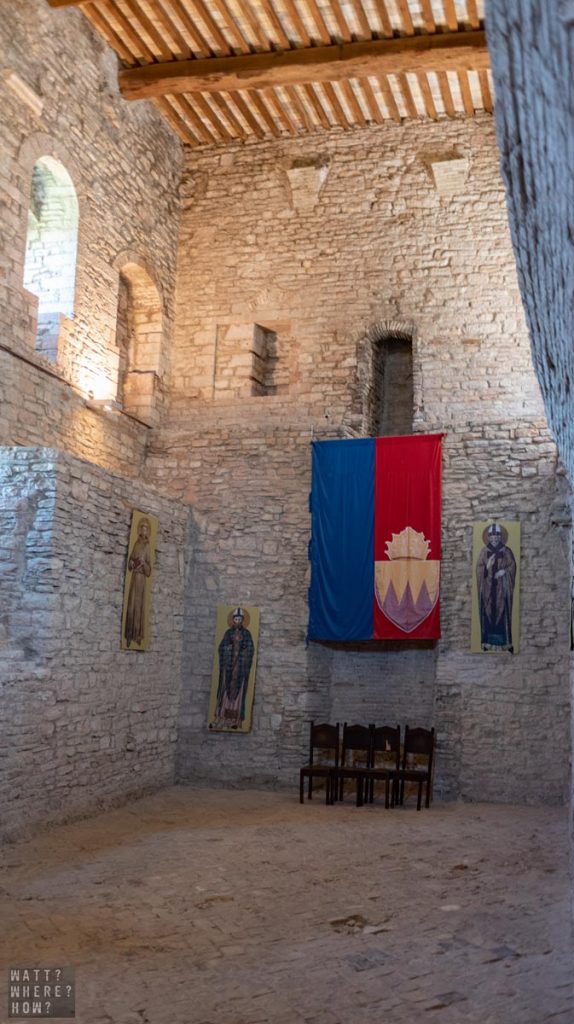
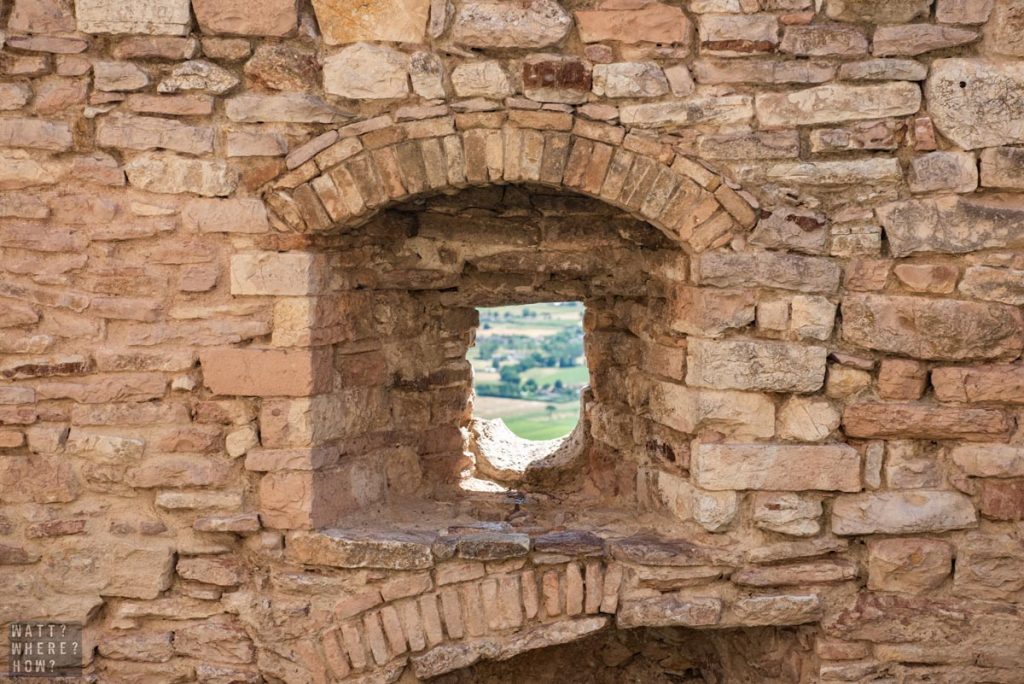
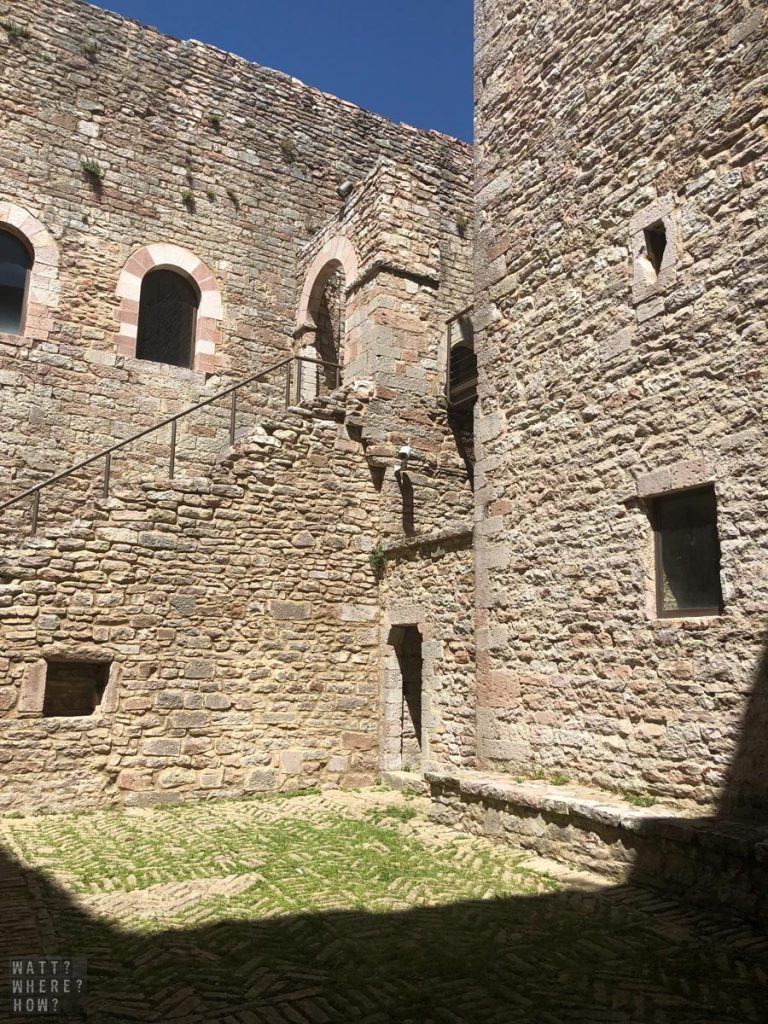
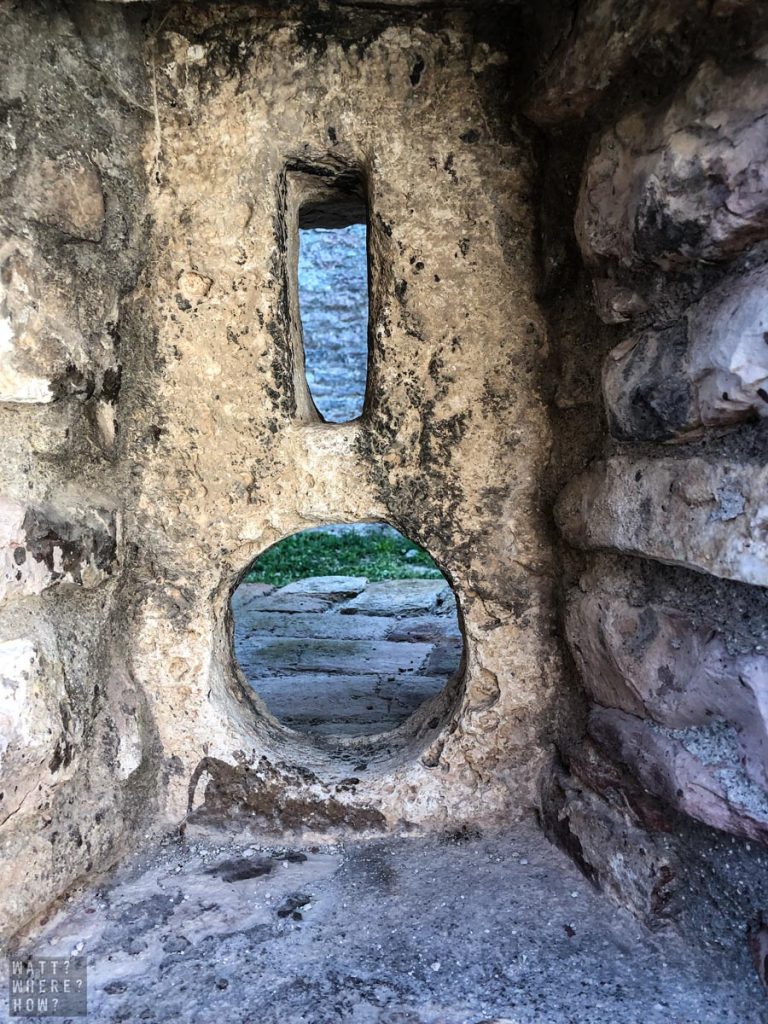
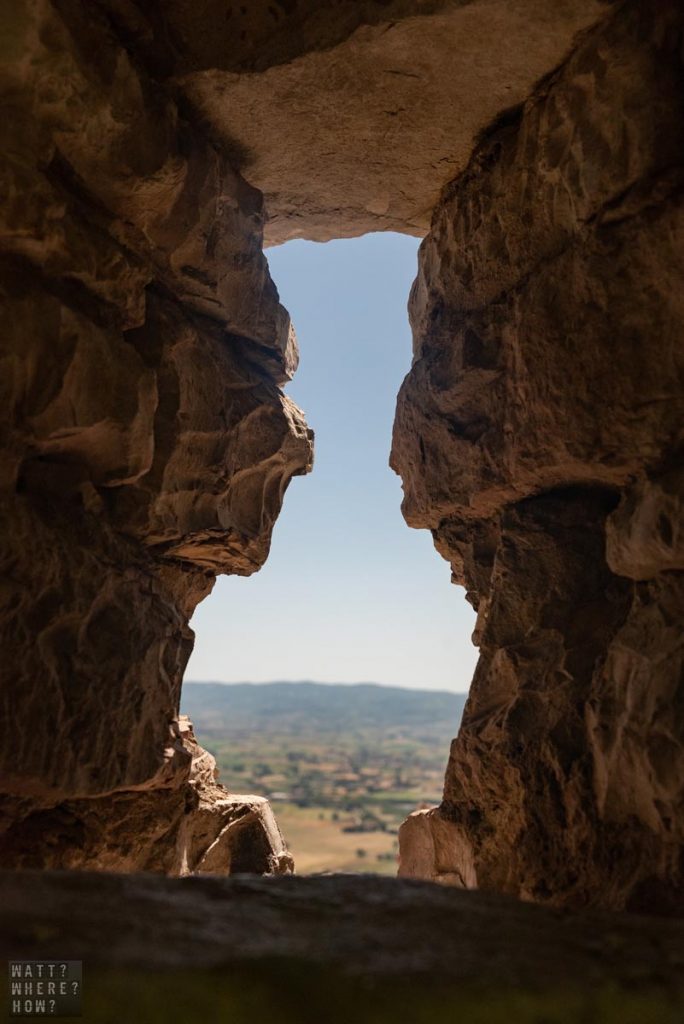
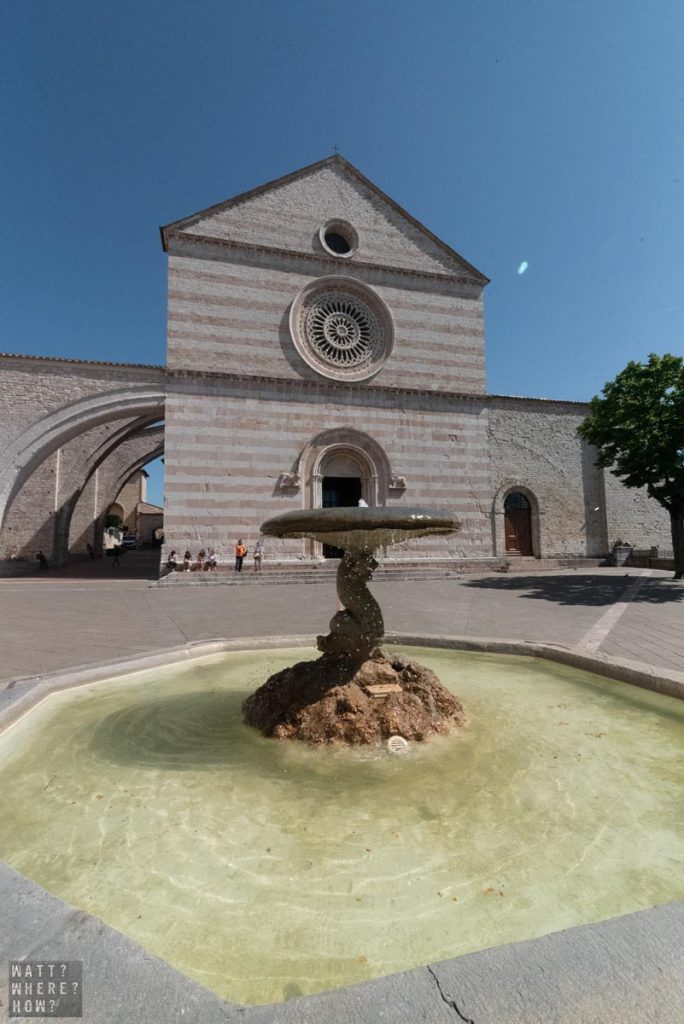
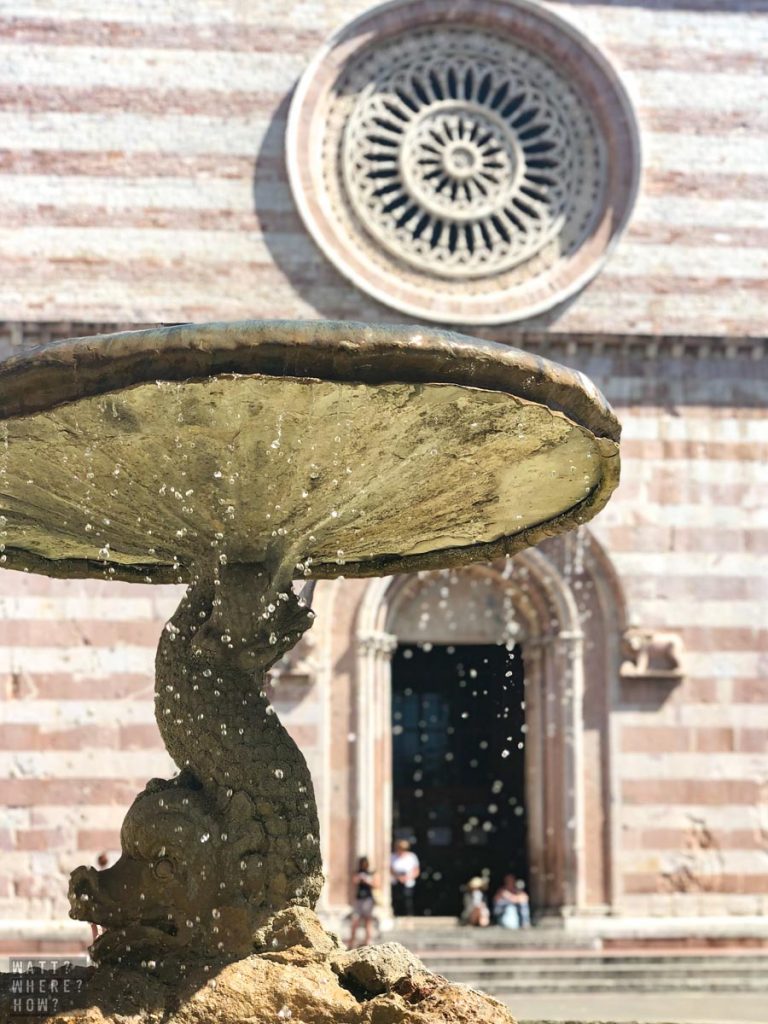
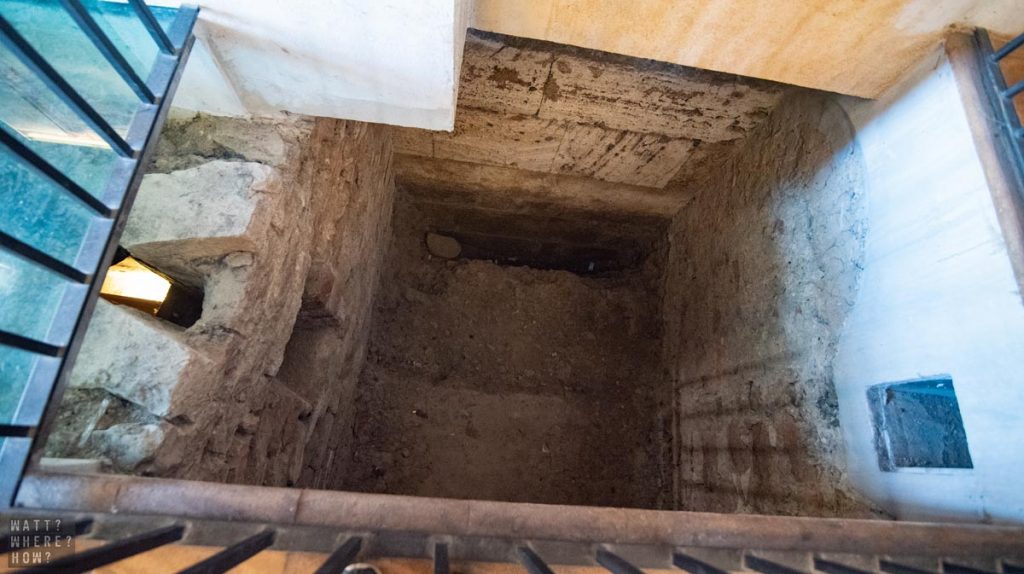
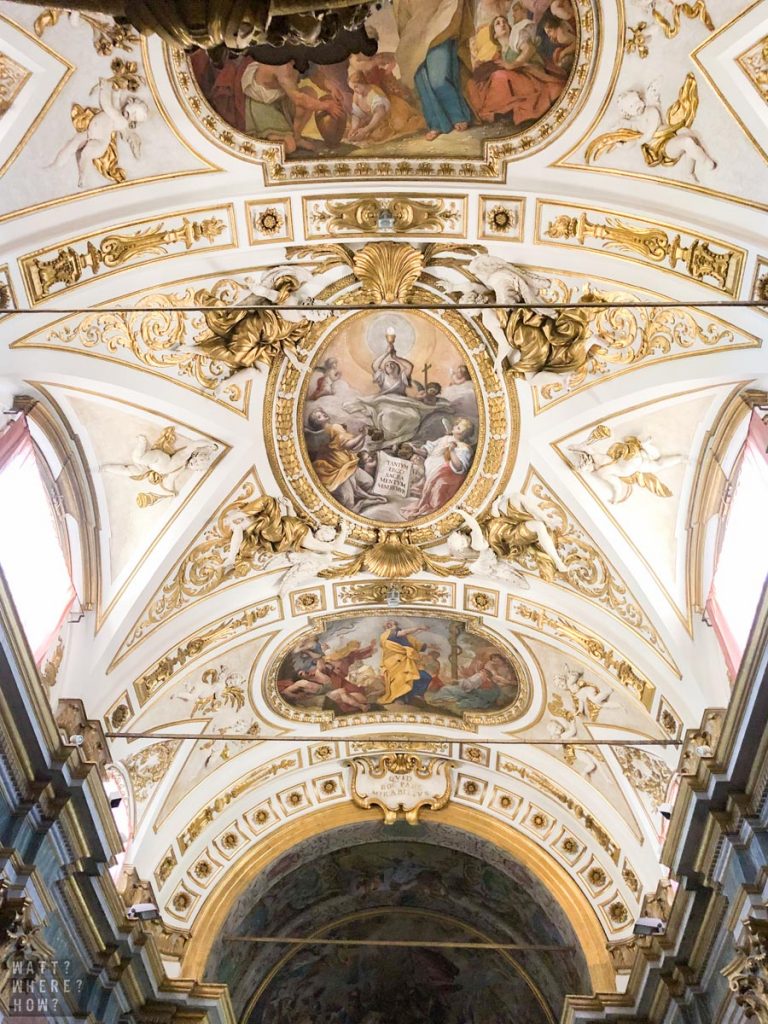
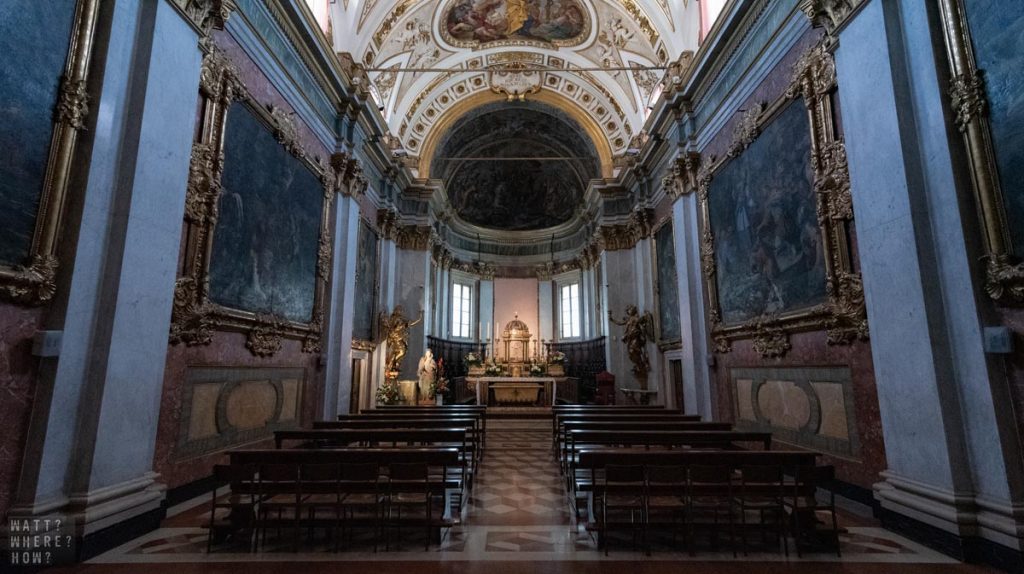
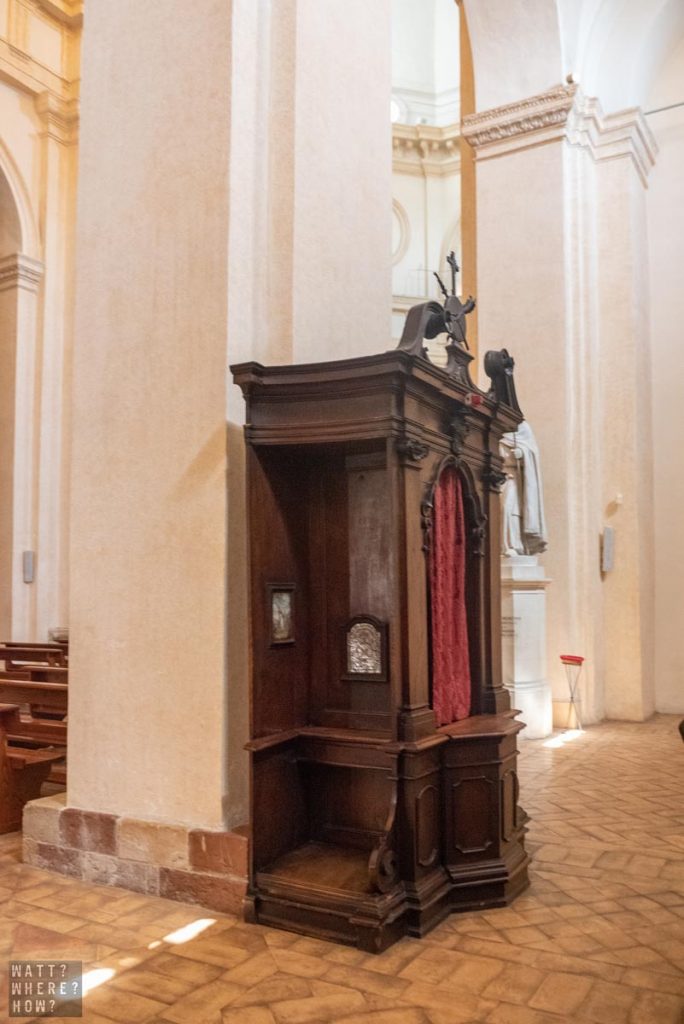
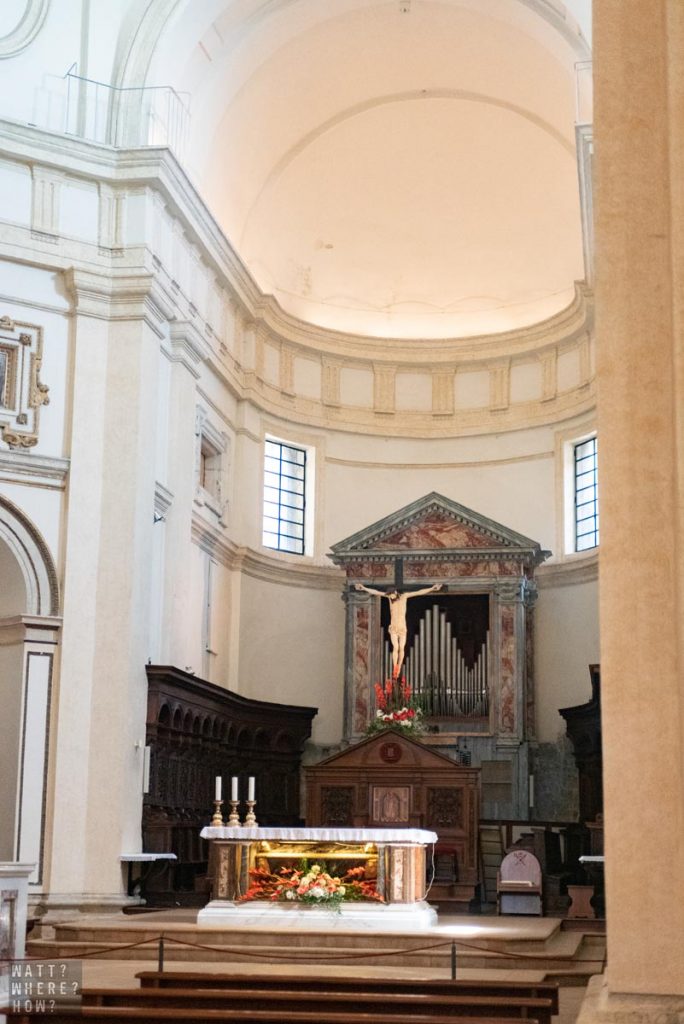
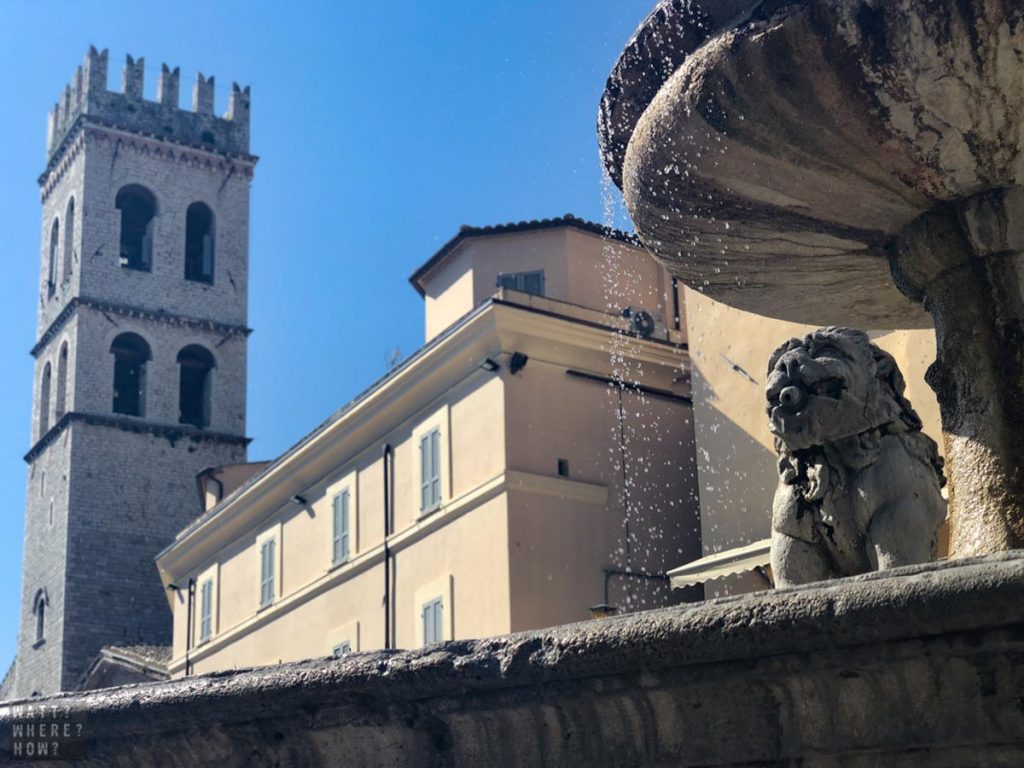
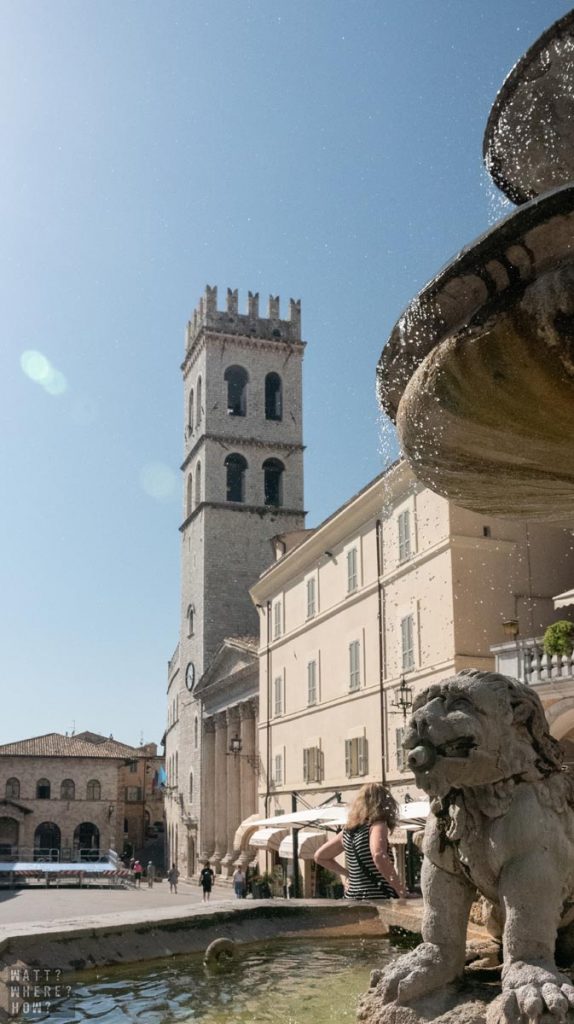
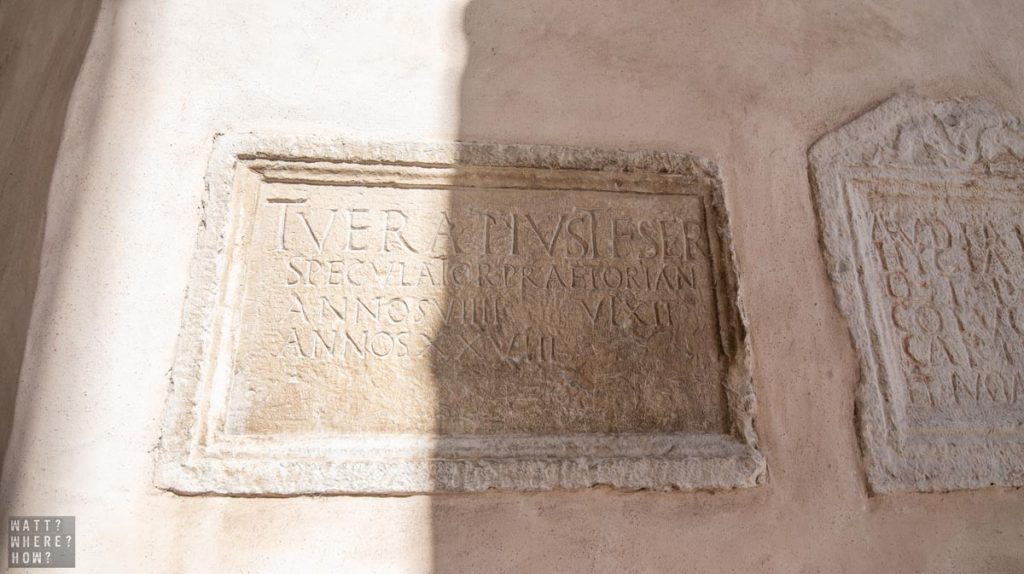
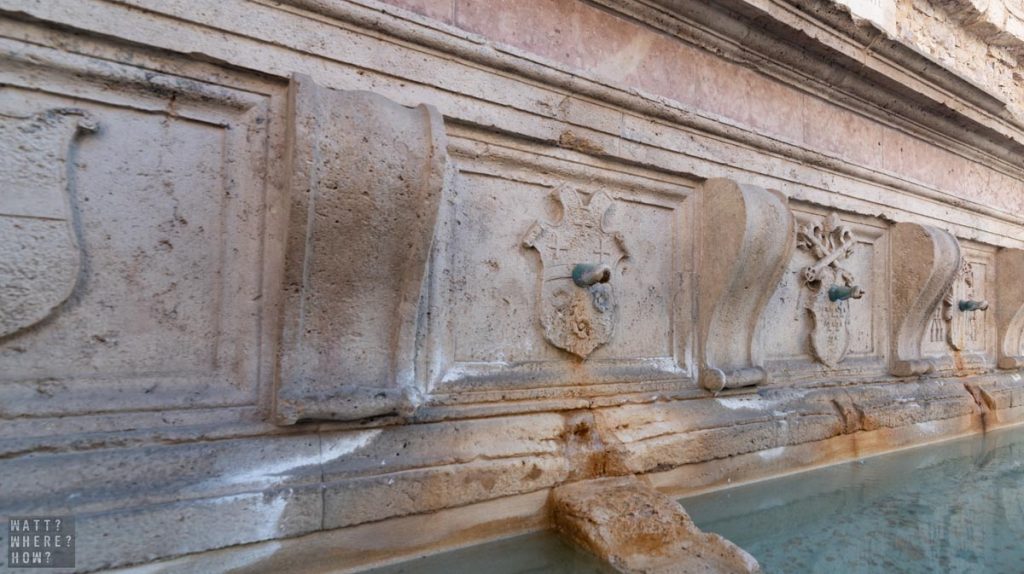
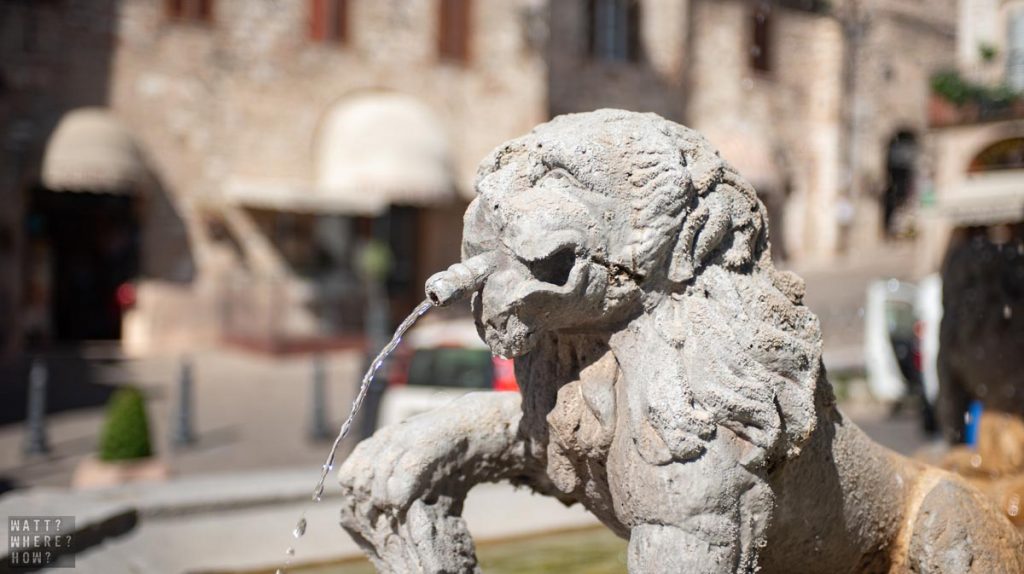
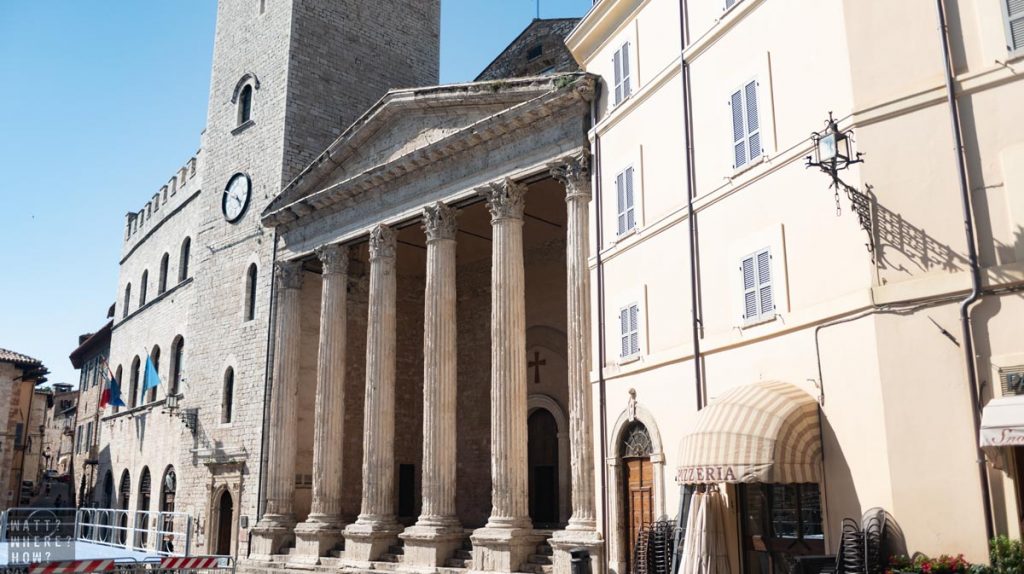

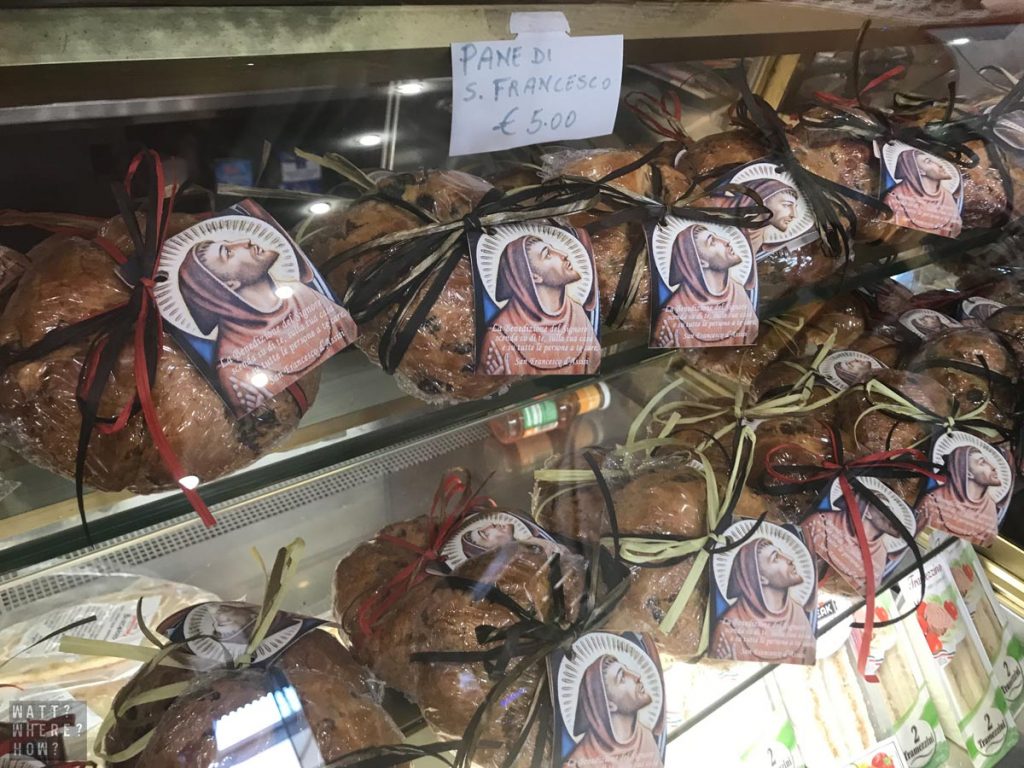

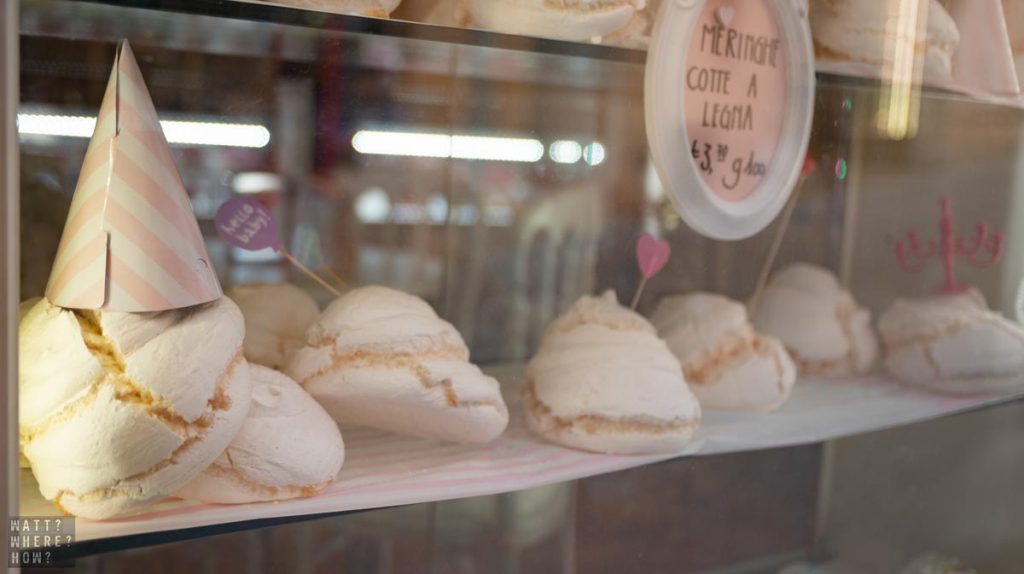
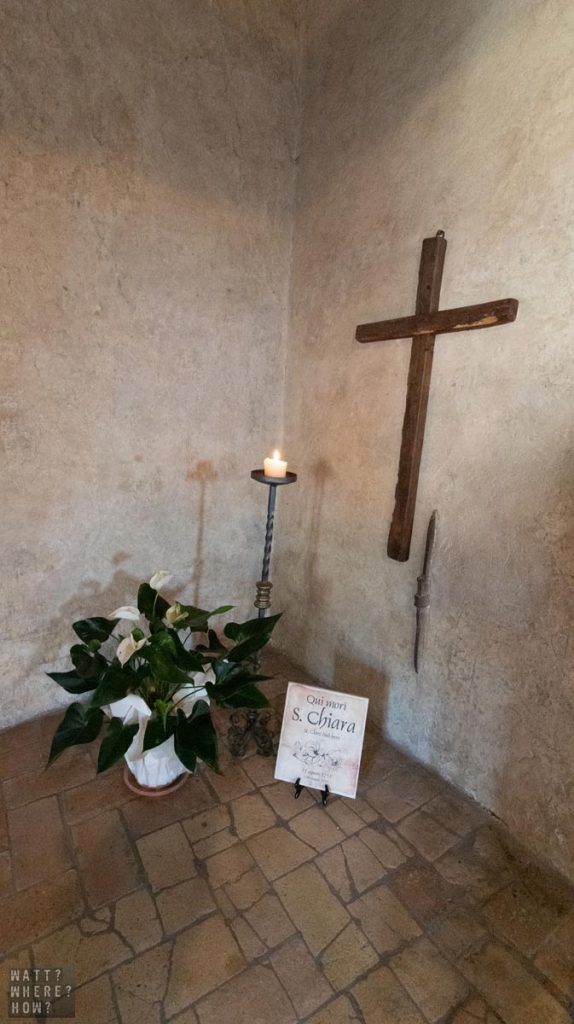
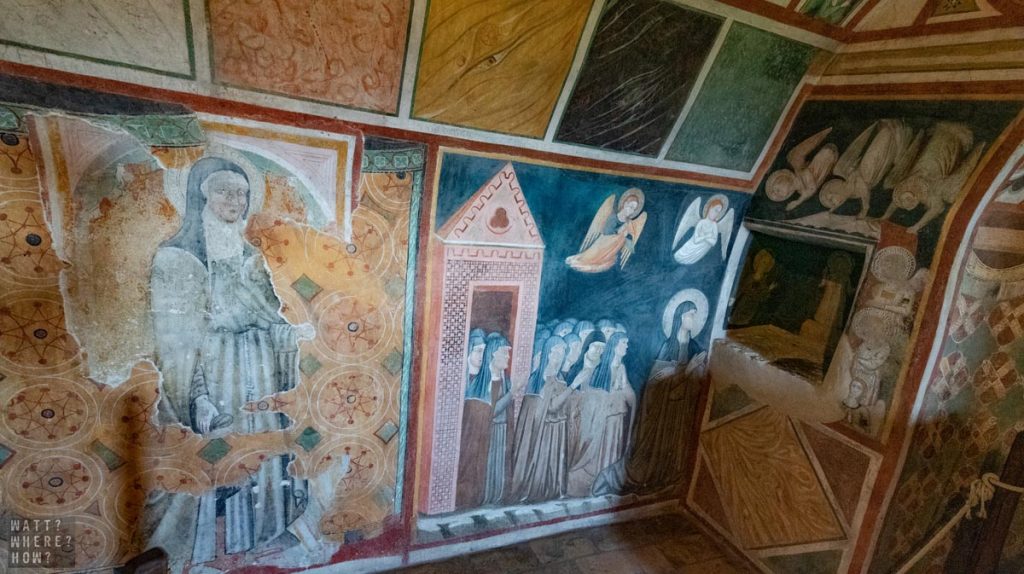
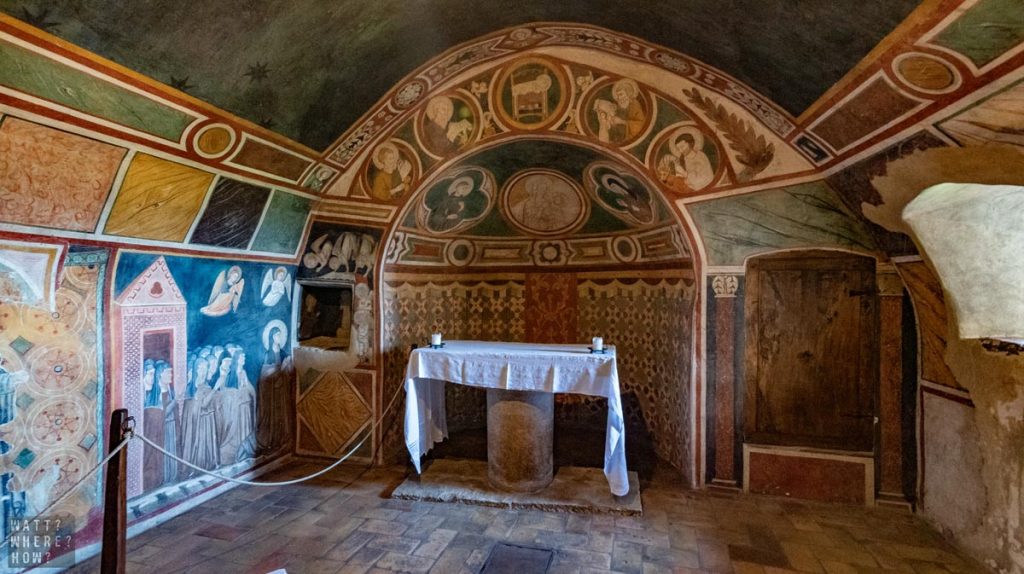
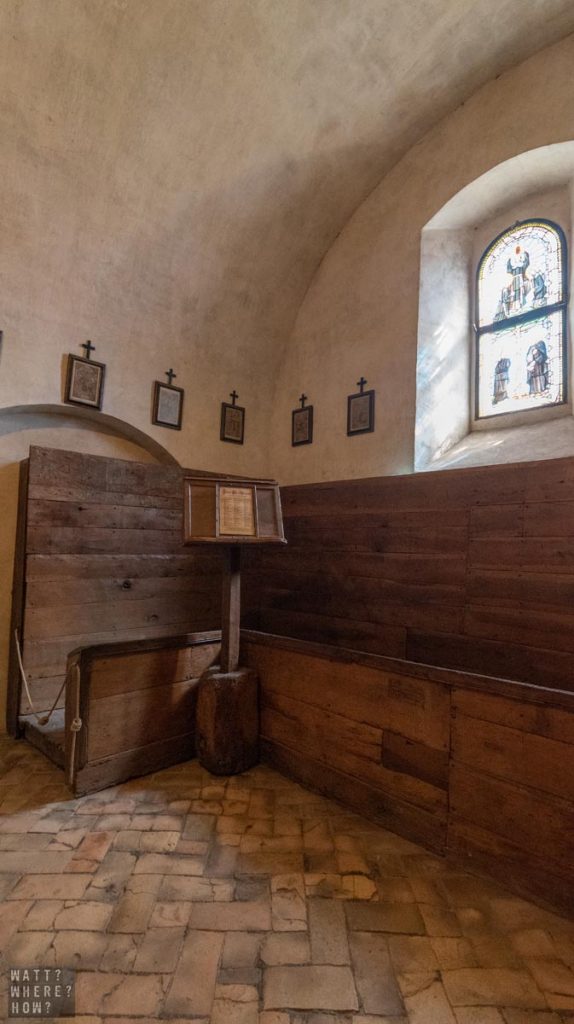
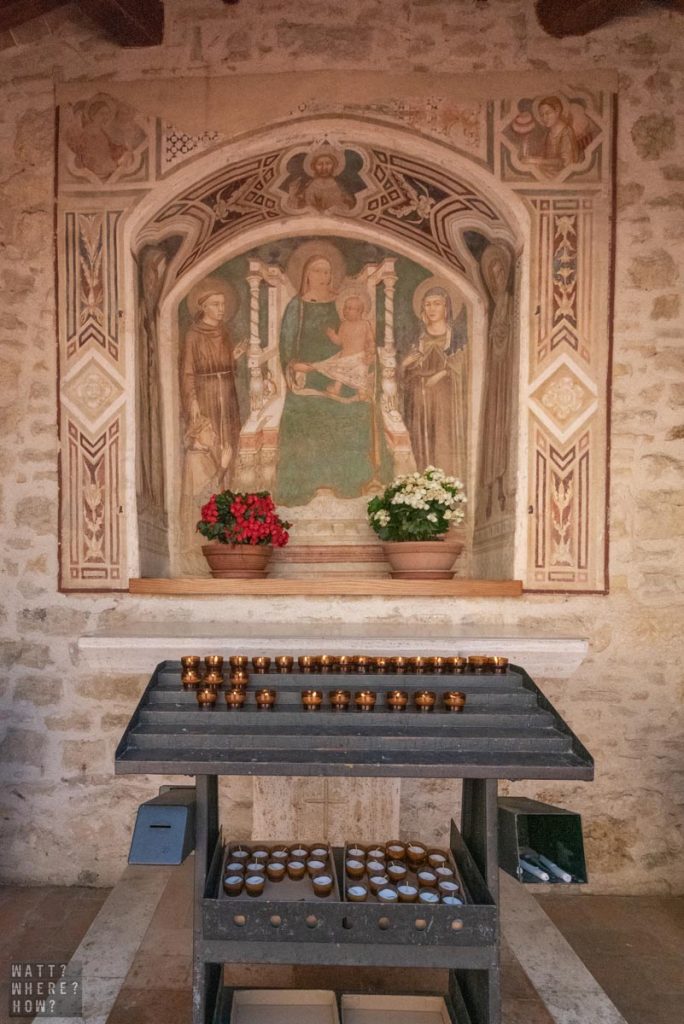
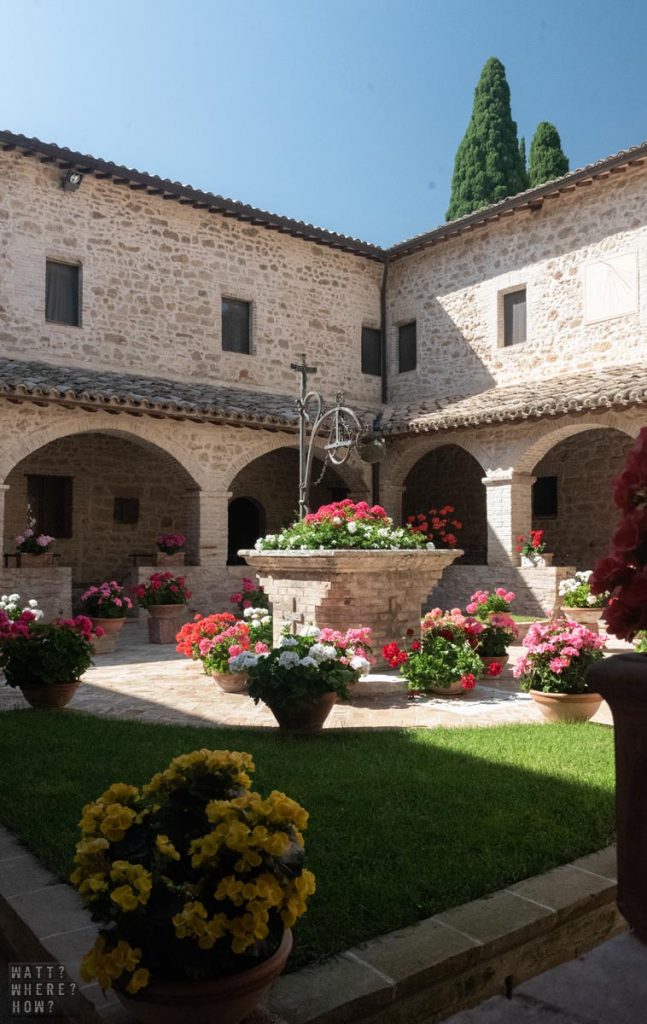
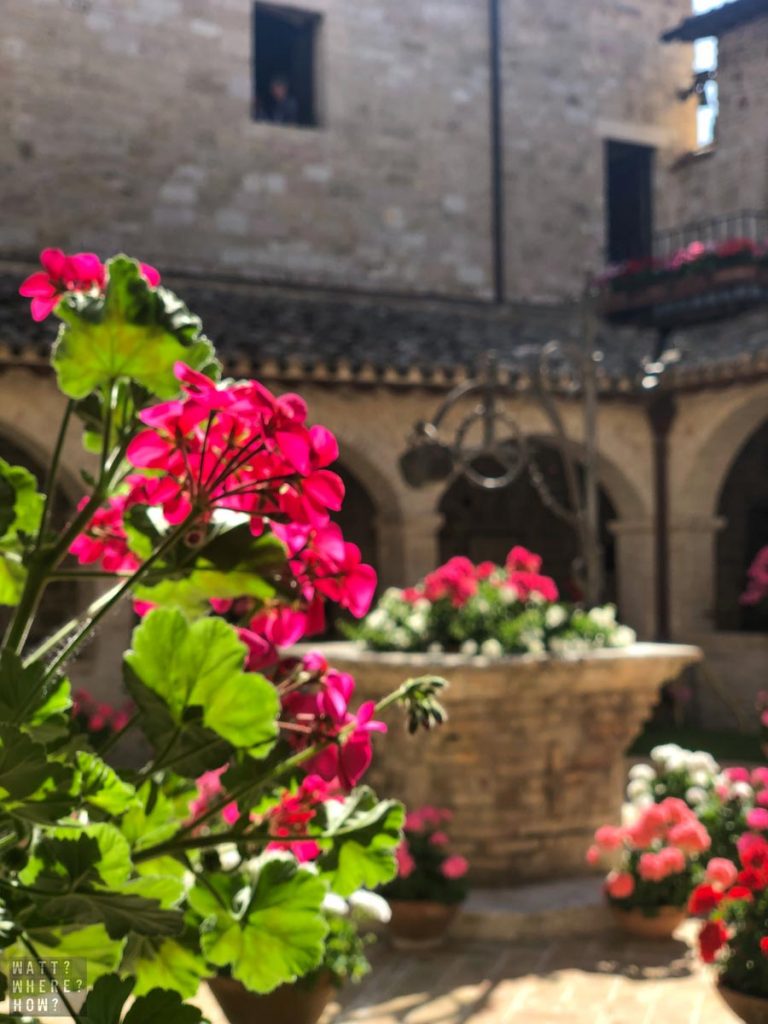
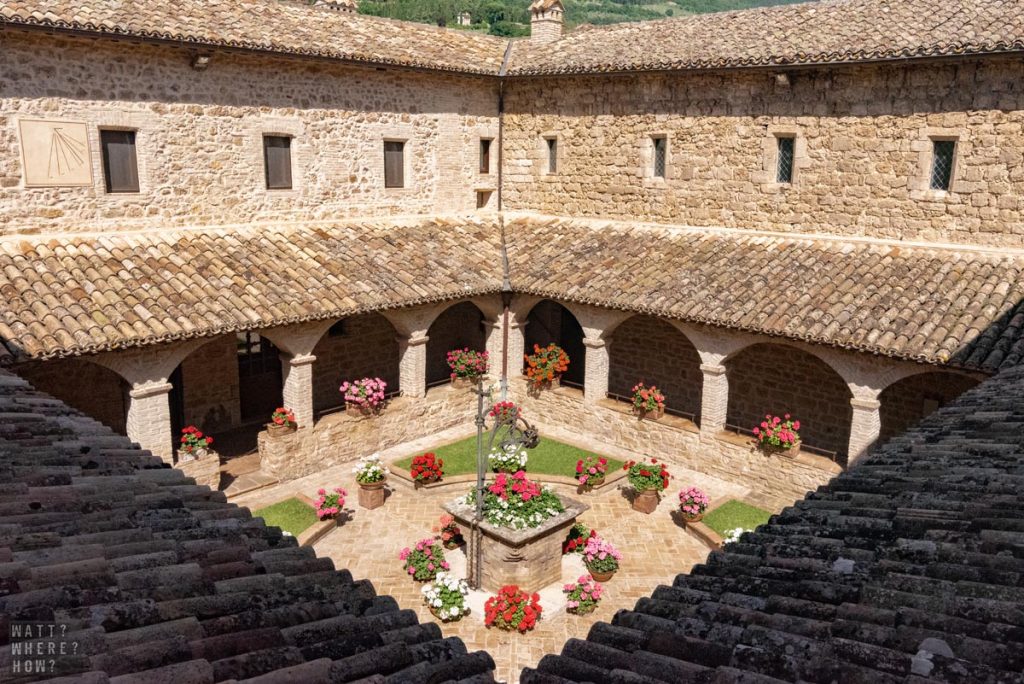
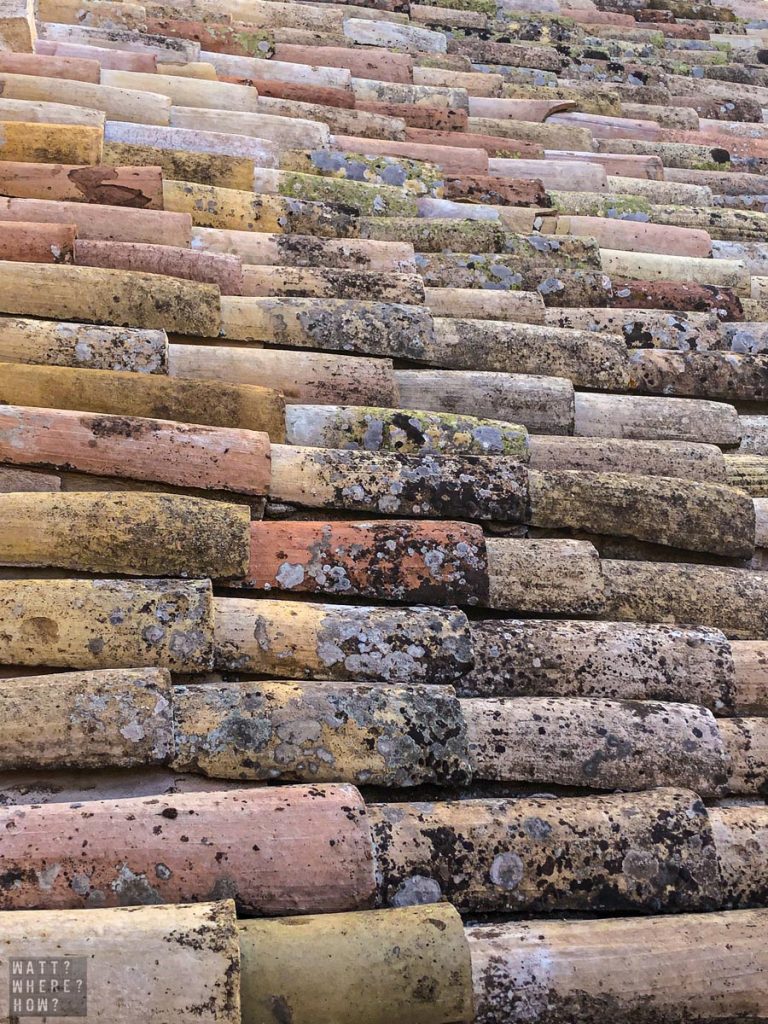
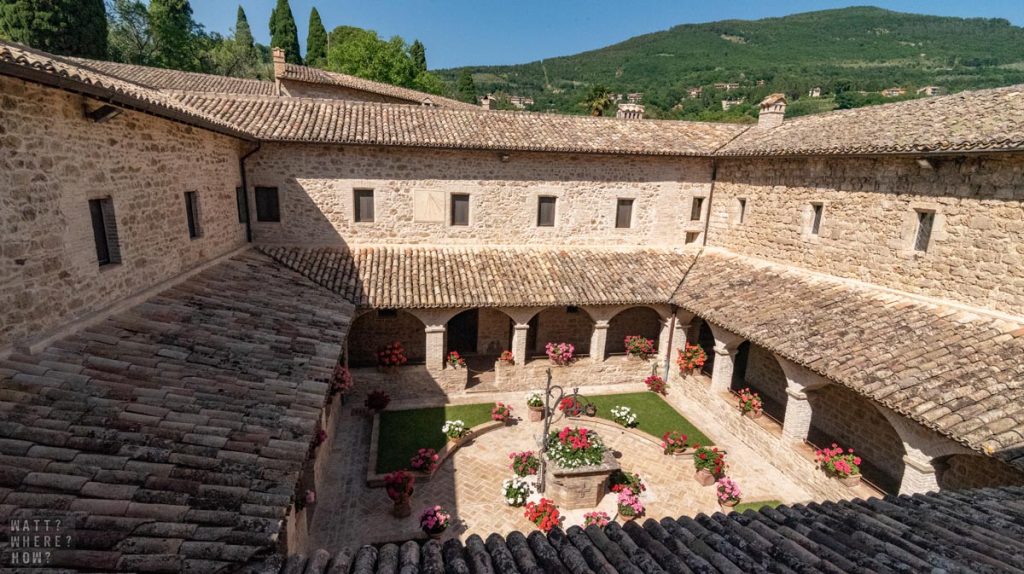
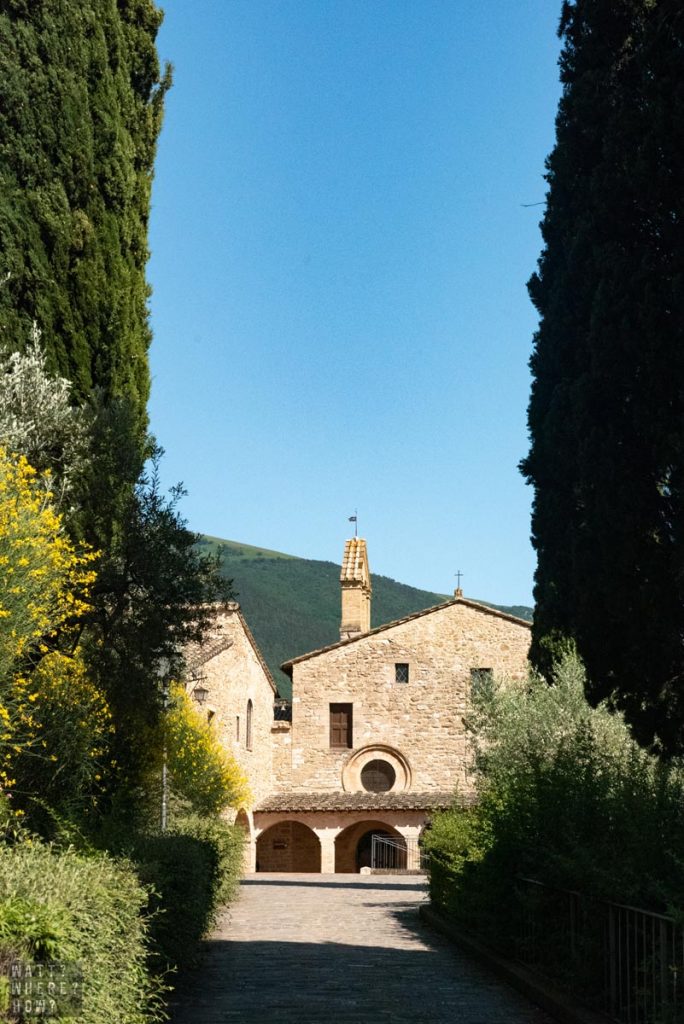
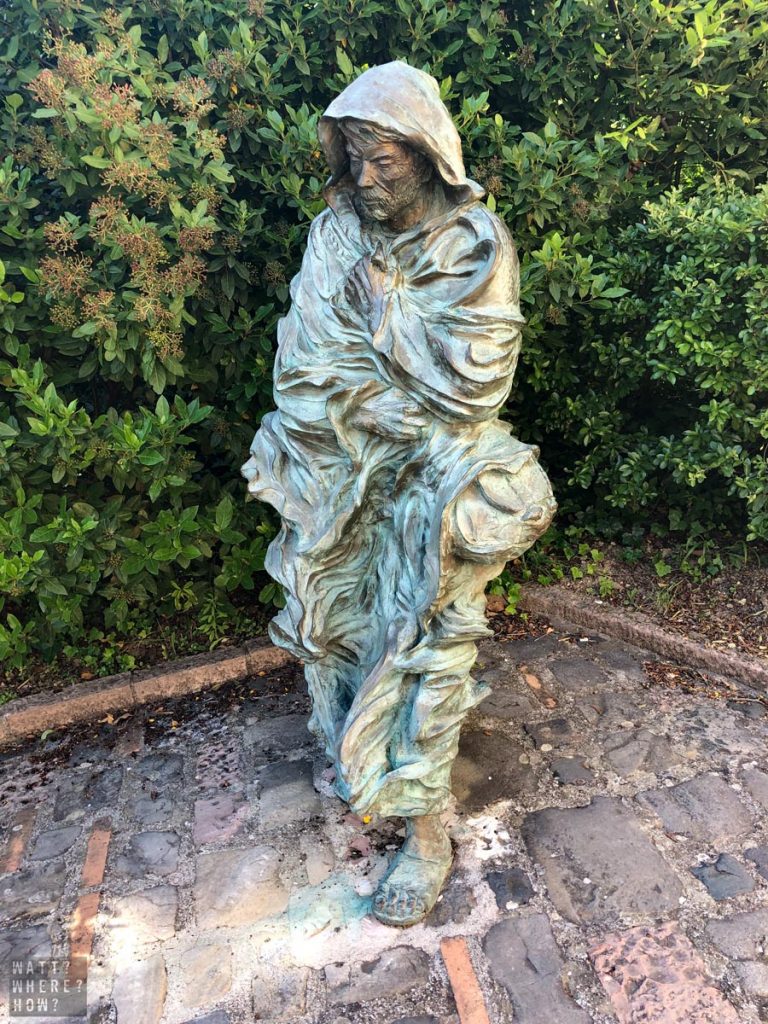
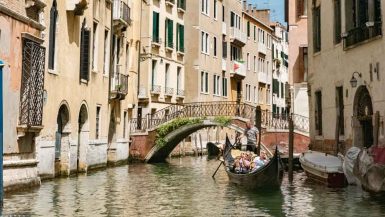
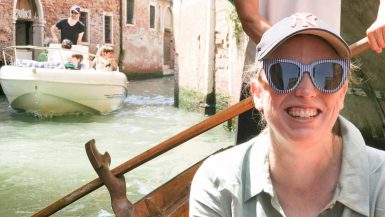
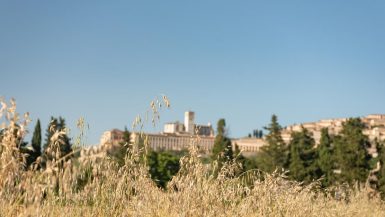
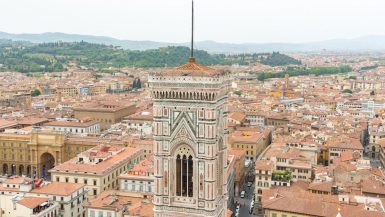
This is an amazing guide to visiting Assisi! I’d love to go one day – the history seems so rich and well-preserved. Camping in the olive groves also sounds like such a neat experience.
Camping in the olive groves on the side of a hill looking over the plains WAS pretty special.
What a great detailed guide to Assisi. We haven’t been there yet, but it looks and sounds like our kind of place. I’d especially like to climb to the top of Rocca Maggiore for the view and I enjoy historical sites.
Wendy, it’s truly amazing – so much history. I think the closest WA has to it is New Norcia
I had not given much thought to Assisi before but I am captured! I love the history but the architecture & art are incredible! Thank you for sharing!
It’s well-known in Italy and popular with pilgrims, but it has so much to offer those who don’t believe too. The farm stay was a true standout too.
🙋♂️I love history and this was very interesting. Beautiful photos that make me feel I’m standing right there.
Great looking town! I’ve been putting off the visit to Assisi for quite some time, but I think I’m due to visit next time!
You must be running out of Italian towns by now!
I’ve seen Assisi on the maps but never knew anything about it. Nor knew it was such a delightful village! I never knew the story about st. Francis, so thanks for sharing that!! Weird but interesting 🙂
Totally 🙂 Not one to sprout religion, but it explains the significance of all the different spots in the town and their role in it all!
Amazing post, as always, you two! We didn’t make it during our last trip to Italy, but it’s definitely on the list! Your pictures are amazing (and, of course, the kitty is particularly on theme for the post ;)) xx
Thanks Julianne. Next time we go to Italy, I’ll drive – we had to choose places accessible by train. A car will open up so many more medieval villages. And yes, cats for the win!
Great post, guys. Brought back lots of fond memories. I visited this town several times, but the last visit is more than twenty-five years ago. Love the history bit and can totally get why Francis’s dad was a tad unamused…
Awww thanks! I went as a 13-year-old and we camped in the olive groves. It had changed a bit since, but definitely has a magical energy to it.